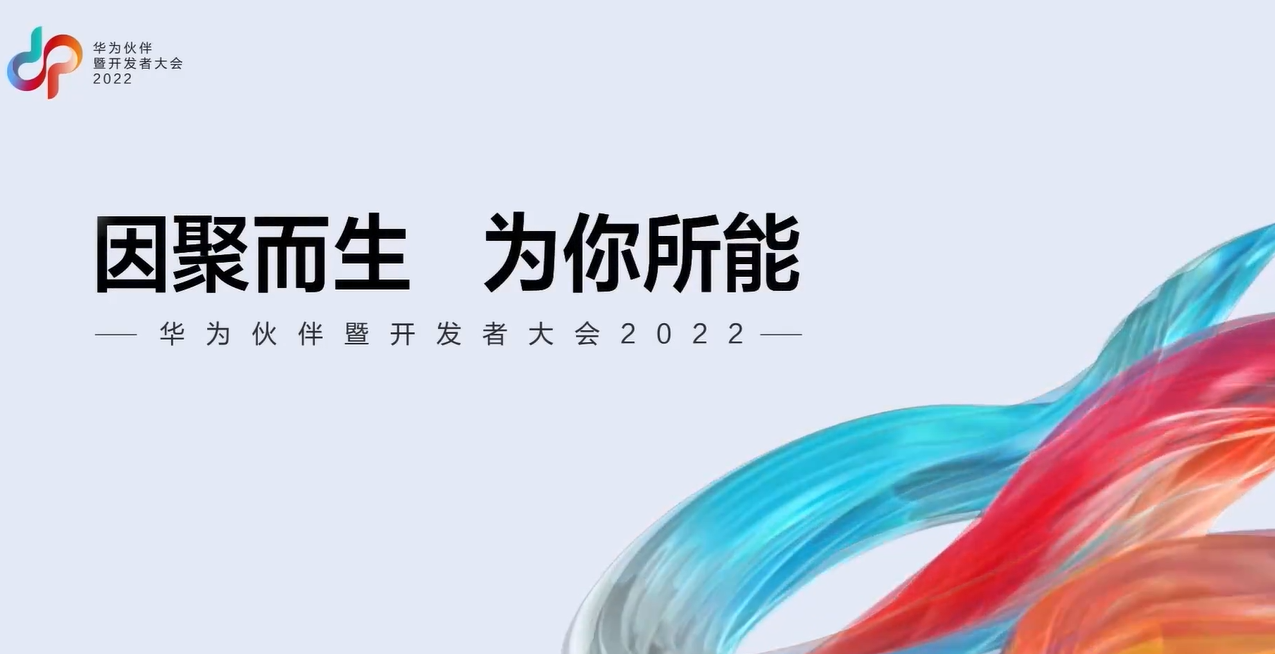
To cultivate excellent engineering talents, it is necessary to mobilize the enthusiasm of universities and enterprises, and realize the deep integration of production, education and research. This is the inevitable path of the supply-side reform of higher education. In recent years, the Ministry of Education has implemented the industry-university cooperation collaborative education project, driven by the latest needs of industrial development to drive the reform of efficient talent training models, and supported more than 1,100 undergraduate colleges and more than 1,000 companies to establish 79,000 projects in cooperation. Enterprises provide Funding and hardware and software support nearly 20 billion yuan. Among them, the Ministry of Education and Huawei have jointly built 72 smart base education bases, which have become an important demonstration project for deepening the integration of production and education and collaborative education. The intelligent base base can continue to deepen reforms, play a pioneering role in radiation, drive more enterprises to invest in talent training, and create a win-win ecology.
One is to pay more attention to concept improvement. The exploration of industry-university cooperation can be roughly divided into three stages. The first stage is the stage of industry-university cooperation, which is characterized by the cooperation between schools and industry enterprises on certain specific issues. The second stage is the stage of industry-university cooperation, where both schools and enterprises reach a consensus on the main links of talent training and take concerted actions. The third stage is the stage of integration of production and transportation, in which enterprises are deeply involved in the whole process of talent training. In the future, we will further promote the comprehensive improvement from school-enterprise cooperation to integration, and realize two-way interaction and two-way project empowerment.
The second is to pay more attention to the co-construction of elements. Huawei and 72 smart pedestal bases have opened a total of 1,500 related courses, compiled more than 10 textbooks, held 16 teacher training sessions, and made positive progress in the joint construction of elements. In the future, it is necessary to further use the real scenes, real problems, and real cases of the industry as talent training resources, and timely incorporate the cutting-edge content of industrial development into curriculum construction, teaching material development, and teacher training, so as to improve the quality of the core elements of talent training.
The third is to pay more attention to the chain connection. The intelligent base base provides strong support for key links such as student course learning, scientific research challenges, and internship employment through the development of course construction, planting plans, and high-quality material plans. In the future, it is necessary to further promote the organic connection of the education chain, talent chain, innovation chain, and industrial chain, and explore a benign interactive model of talent training, technological innovation, and industrial development. The fourth is to pay more attention to technology empowerment. At present, Huawei has cooperated with relevant universities to develop and launch more than 20 high-quality MOOCs, started the construction of 17 virtual examination rooms, provided more than 30 million Huawei cloud resources to support teaching, and relied on information technology to break through the boundaries of time and space and improve teaching efficiency. It is hoped that Huawei can further leverage its technological advantages and efficiency in the information field, and continue to explore new forms of smart home education. Industry-education integration, collaboration and people are dictated by laws and forms. We must strive to promote the integration of industry-education as inevitable and achieve higher-quality co-construction and sharing. In the future, the Department of Higher Education of the Ministry of Education will continue to support the smart base project. It is hoped that Huawei and relevant universities will continue to improve the quality of base construction, summarize and condense typical experience, and lead more companies and universities to promote collaborative education, and jointly build a world engineering innovation center and talents. Cultivate high ground.
The intelligent pedestal cultivates talents with the latest technology and leads the industry with innovative talents. Under the guidance of the Ministry of Education, it connects the main body of schools and enterprises, connects teaching elements, and connects time and space. Since the launch of the project, it has achieved fruitful results, empowering more than 3,500 pioneer teachers, offering more than 1,500 courses, and training more than 300,000 students. Here, on behalf of the joint working group of the Huawei Smart Pedestal of the Ministry of Education, I would like to express my sincere thanks to the school leaders, teachers and students who participated in and supported the Smart Pedestal project. Technology is the root and talent is the foundation. We will continue to deepen the smart base project, practice the integration of production and education in science and engineering majors, and integrate Kunpeng, Shengteng, Euler Gossens and other industrial root technologies into university teaching, so that students Learning and industry needs are closely integrated, and you can deeply participate in the innovation and construction process of new technologies, new architectures, and new ecology, and participate in real industrial tasks and real problems to stimulate teachers' teaching and students' interest in learning.
We have recently benchmarked this year's plan with 72 smart pedestal colleges and universities, including the construction of new courses. We will launch more than 40 textbooks and supplementary books and 23 high-quality recorded courses this year. We will also release an award program for excellent teaching resources on smart pedestals to encourage more teachers to flourish, develop teaching materials and MOOCs independently, and implement new practices at the same time. We open up real tasks in the industry, allowing students to do real problems in a real industrial environment and improve their ability to practice and innovate.
This year, we plan to invest a total of 360 million Crowdwisdom incentive funds, and release more than 4,000 Kunpeng Ascension Crowdwisdom projects, all of which will be posted on the Kunpeng Community and the Ascend Community. Developers and college teachers and students are welcome to actively participate in the claim, and finally explore a new model of teaching, teaching and research. We will build 17 virtual teaching and research rooms for the Ministry of Education's smart base courses, and at the same time launch a university talent development community integrating teaching practice innovation and technology exchange, formulate base projects, and orderly implement the 72 pilot construction universities. Talent training has embarked on an innovative path of integration of production and education. We hope to extend the achievements and experience obtained by the smart base to more universities and enterprises, and jointly carry out the training of talents in the computing industry.
We plan to build a batch of Kunpeng Shengteng production, education and education bases across the country to train more computing industry talents who have mastered Kunpeng Shengteng's root technology. We released the Olagauss Talent Development Acceleration Plan and the Artificial Intelligence Talent Development Acceleration Plan. Through these acceleration plans, we will cultivate a group of professionals with in-depth research in specific subdivided technical directions. We look forward to more schools, teachers and students joining our team and working together to make Kunpeng a must-have skill for science and engineering students. To cultivate outstanding talents who can create a new round of scientific and technological revolution and computing industry revolution for the era of digital economy. Let us work together to light up every future star and shine together in the sea of stars in the digital age.
Exploration and Practice of Training New Engineering Talents
We all know that higher education and economic and social development are inseparable from each other. In particular, engineering education in higher education has been continuously developing along with the global technological revolution and industrial transformation. Technological innovation and industrial development have promoted the iterative upgrading of the modern engineering education paradigm. From technology paradigm, science paradigm, engineering paradigm to the current innovation paradigm. At the same time, the talents cultivated by engineering education serve as support and lead the development of technology and industry.
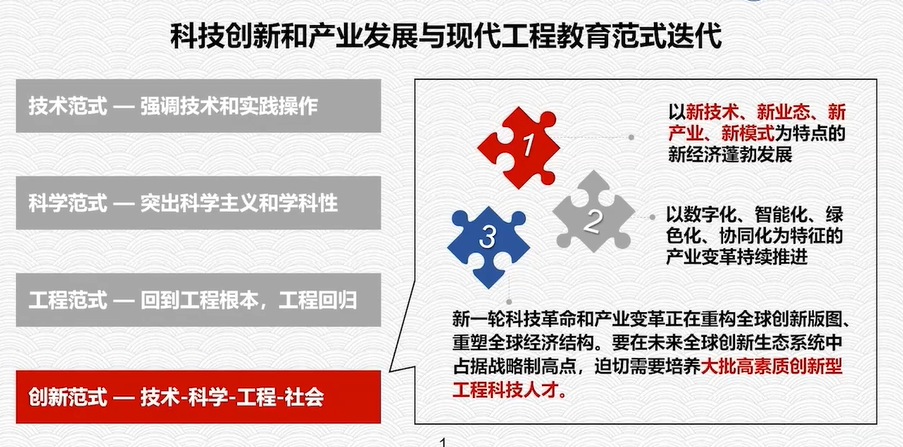 Since the beginning of the 21st century, the technological revolution and industrial transformation of newcomers are reshaping the global innovation map and reshaping the global economic structure. To occupy the strategic commanding heights in the future global innovation ecosystem, it is urgent to cultivate a large number of high-quality innovative engineering and technical talents. Under such a formal background requirement, in 2017, the Ministry of Education issued a notice on publishing new engineering research and practice. In 2018, the Ministry of Education, the Ministry of Industry and Information Technology and the Chinese Academy of Engineering jointly issued relevant opinion requirements. This in turn requires us to actively respond to the challenges of a new round of scientific and technological revolution and industrial transformation, take the construction of new engineering science and education as an important starting point, continue to deepen the reform of engineering education, and accelerate the cultivation of outstanding talents who adapt to and lead the new round of technological revolution and industrial transformation. Engineering and technical personnel.
Since the beginning of the 21st century, the technological revolution and industrial transformation of newcomers are reshaping the global innovation map and reshaping the global economic structure. To occupy the strategic commanding heights in the future global innovation ecosystem, it is urgent to cultivate a large number of high-quality innovative engineering and technical talents. Under such a formal background requirement, in 2017, the Ministry of Education issued a notice on publishing new engineering research and practice. In 2018, the Ministry of Education, the Ministry of Industry and Information Technology and the Chinese Academy of Engineering jointly issued relevant opinion requirements. This in turn requires us to actively respond to the challenges of a new round of scientific and technological revolution and industrial transformation, take the construction of new engineering science and education as an important starting point, continue to deepen the reform of engineering education, and accelerate the cultivation of outstanding talents who adapt to and lead the new round of technological revolution and industrial transformation. Engineering and technical personnel.
Under such a big background, Zhejiang University has made our exploration and practice in combination with its own school-running reality. This year happens to be the 125th anniversary of the founding of Zhejiang University. In 1897, the prefect of Hangzhou was actually Xiang Chaoding, the mayor of Hangzhou, who put the cultivation of talents as the first priority in the home system, and the emphasis on practical learning in the education of talents. Here it is especially pointed out that we should pay attention to practical learning. Because at that time China happened to be at a time when it was defeated in the Sino-Japanese War of 1894-1895, and it was idealistic governance. Therefore, Qiushi Academy published industrial education shortly after its establishment. During the 125 years of running a school, Zhejiang University has always adhered to seeking truth and innovation, school motto, and training, and has created a large number of scientists, outstanding engineering talents, cultural masters, and elites from all walks of life. Zhejiang University is a comprehensive research university with strong engineering strength. At present, we have 11 engineering disciplines that have been selected as double-first-class construction disciplines, and we also have a relatively large number of national key laboratories and national engineering research centers, which have a deep accumulation and fruitful results in the cultivation of engineering talents. However, in our work and practice, we also found that we have entered a new era, and there are also problems and challenges in the training of our engineering talents.
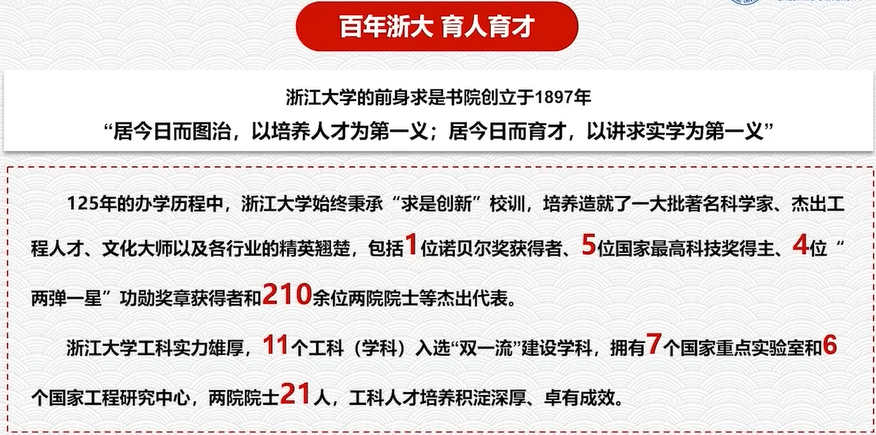 The main point of view is that there are some, first of all, our professional system tends to be solidified, the overall setting is not wide enough, and the degree of interdisciplinary is not strong enough. However, our knowledge system is relatively outdated, does not fully meet the actual needs of the industry, and does not fully reflect some of the latest developments in science and technology. In addition, the reform of our teaching and learning model is insufficient. Now teaching is mainly based on teacher lectures, students are relatively passive in learning, knowledge transmission is the main focus, and ability training is relatively insufficient. In addition, the cultivation of engineering talents is particularly important because the cultivation of practical and innovative abilities is still lacking. Especially in terms of school-enterprise cooperation, science-education collaboration, etc., our cooperation at a relatively shallow level is relatively loose. Therefore, in the face of such difficult problems and challenges, we at Zhejiang University have also done some thinking and put forward some ideas of ours, which is to propose a path to implement the construction of new engineering disciplines through four innovations.
The main point of view is that there are some, first of all, our professional system tends to be solidified, the overall setting is not wide enough, and the degree of interdisciplinary is not strong enough. However, our knowledge system is relatively outdated, does not fully meet the actual needs of the industry, and does not fully reflect some of the latest developments in science and technology. In addition, the reform of our teaching and learning model is insufficient. Now teaching is mainly based on teacher lectures, students are relatively passive in learning, knowledge transmission is the main focus, and ability training is relatively insufficient. In addition, the cultivation of engineering talents is particularly important because the cultivation of practical and innovative abilities is still lacking. Especially in terms of school-enterprise cooperation, science-education collaboration, etc., our cooperation at a relatively shallow level is relatively loose. Therefore, in the face of such difficult problems and challenges, we at Zhejiang University have also done some thinking and put forward some ideas of ours, which is to propose a path to implement the construction of new engineering disciplines through four innovations.
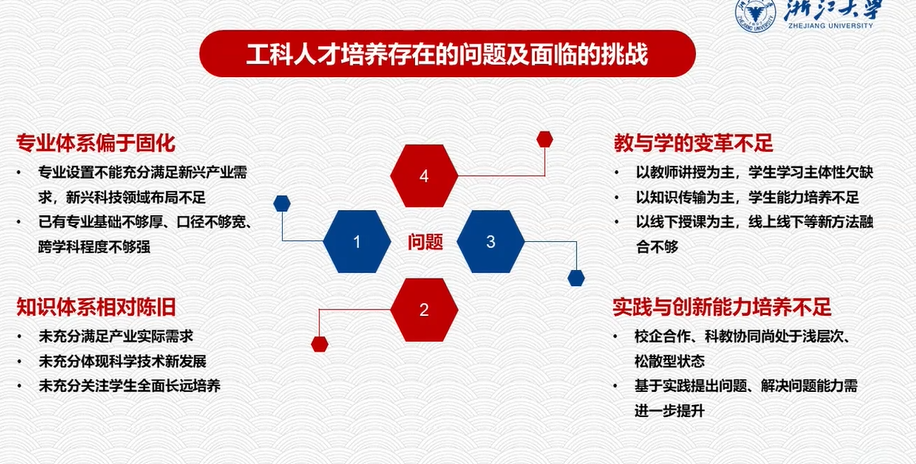 New majors, new connotations, new models, and new methods. There are so many jobs in the so-called new major. Firstly, we have optimized the professional setting. By serving the national strategy and economic and social development, we use three principles to transform the majors. One is to support the legacy academic disciplines. The second is to guide the cultivation of broad-based foundations in the future. Then, with the goal of building legacy majors, we upgrade advantageous majors, iterate inefficient majors, and lay out emerging majors. We optimized the original 128 majors to 91. Among them, so far, 67 majors have been selected as national first-class professional construction points. Among the 128 majors in the optimization process, 44 of them are engineering majors, and we have further integrated and optimized them to 31. I have listed two examples here. One is our mechanical engineering. We merged the three majors of mechanical engineering, mechatronics engineering, and industrial engineering in the original School of Mechanical Engineering into one major. In this way, with a thicker foundation, the cultivation of an appropriate wider caliber can be installed. Another example is that we, as some projects, have also made similar transformations. Of course, there are many other examples like this, and I won’t list them one by one here. In general, I use such an idea of optimizing major settings to transform existing majors.
New majors, new connotations, new models, and new methods. There are so many jobs in the so-called new major. Firstly, we have optimized the professional setting. By serving the national strategy and economic and social development, we use three principles to transform the majors. One is to support the legacy academic disciplines. The second is to guide the cultivation of broad-based foundations in the future. Then, with the goal of building legacy majors, we upgrade advantageous majors, iterate inefficient majors, and lay out emerging majors. We optimized the original 128 majors to 91. Among them, so far, 67 majors have been selected as national first-class professional construction points. Among the 128 majors in the optimization process, 44 of them are engineering majors, and we have further integrated and optimized them to 31. I have listed two examples here. One is our mechanical engineering. We merged the three majors of mechanical engineering, mechatronics engineering, and industrial engineering in the original School of Mechanical Engineering into one major. In this way, with a thicker foundation, the cultivation of an appropriate wider caliber can be installed. Another example is that we, as some projects, have also made similar transformations. Of course, there are many other examples like this, and I won’t list them one by one here. In general, I use such an idea of optimizing major settings to transform existing majors.
 After that, we have also laid out emerging majors. Based on the strategic needs of the country, the development needs of future industries, and the needs of cutting-edge progress in disciplines, we have added new engineering majors such as artificial intelligence, robotics engineering, and information security in recent years.
After that, we have also laid out emerging majors. Based on the strategic needs of the country, the development needs of future industries, and the needs of cutting-edge progress in disciplines, we have added new engineering majors such as artificial intelligence, robotics engineering, and information security in recent years.
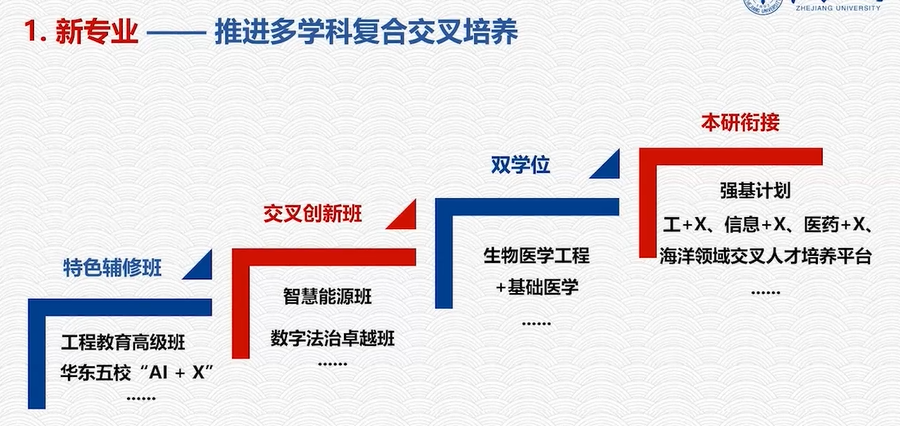 In the new major, we also give full play to the multidisciplinary advantages of Zhejiang University. Facing the typical feature of our future development that requires the cross-combination of knowledge disciplines, we have promoted the multi-disciplinary compound cross-training. For example, we have unique minor classes, cross-innovation classes, and double degrees. We integrate two different majors so that students can master this compound knowledge after learning, and we also explore the combination of undergraduate and graduate students. Linking up, through engineering information plus, etc., we can realize the cultivation of our interdisciplinary talents, so that our students have a stronger knowledge and ability structure that can adapt to future needs.
In the new major, we also give full play to the multidisciplinary advantages of Zhejiang University. Facing the typical feature of our future development that requires the cross-combination of knowledge disciplines, we have promoted the multi-disciplinary compound cross-training. For example, we have unique minor classes, cross-innovation classes, and double degrees. We integrate two different majors so that students can master this compound knowledge after learning, and we also explore the combination of undergraduate and graduate students. Linking up, through engineering information plus, etc., we can realize the cultivation of our interdisciplinary talents, so that our students have a stronger knowledge and ability structure that can adapt to future needs.
 The second is our new connotation. Our focus on the new connotation is the curriculum and curriculum system. First of all, we have built such a characteristic curriculum system that integrates the four classrooms. We divide a class into about 150 credits. As the main front for talent cultivation, we mainly master the systematic knowledge and skills in this class, and promote the interaction with teachers in this class. In addition, we considered the need for a combination of classroom and extracurricular activities, and set up 2 classrooms to unite students from different majors to enhance innovation and teamwork. In addition, our third class is mainly a combination of on-campus and off-campus, connecting professional ability and social needs, and allowing students to grow through practice and innovation. Finally, we also set up four classrooms, which reflect the combination of domestic and overseas, promote overseas learning exchanges, and enhance students' global understanding and thinking ability.
The second is our new connotation. Our focus on the new connotation is the curriculum and curriculum system. First of all, we have built such a characteristic curriculum system that integrates the four classrooms. We divide a class into about 150 credits. As the main front for talent cultivation, we mainly master the systematic knowledge and skills in this class, and promote the interaction with teachers in this class. In addition, we considered the need for a combination of classroom and extracurricular activities, and set up 2 classrooms to unite students from different majors to enhance innovation and teamwork. In addition, our third class is mainly a combination of on-campus and off-campus, connecting professional ability and social needs, and allowing students to grow through practice and innovation. Finally, we also set up four classrooms, which reflect the combination of domestic and overseas, promote overseas learning exchanges, and enhance students' global understanding and thinking ability.
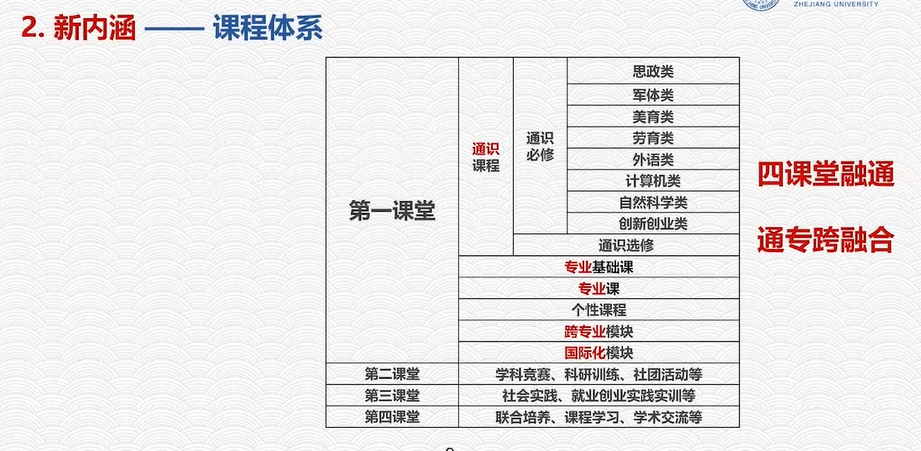 In the setting of our classroom, we have divided the relevant modules into general examination majors, personality, inter-professional, internationalization and so on. Here I mainly briefly report on news agency education and professional education.
In the setting of our classroom, we have divided the relevant modules into general examination majors, personality, inter-professional, internationalization and so on. Here I mainly briefly report on news agency education and professional education.
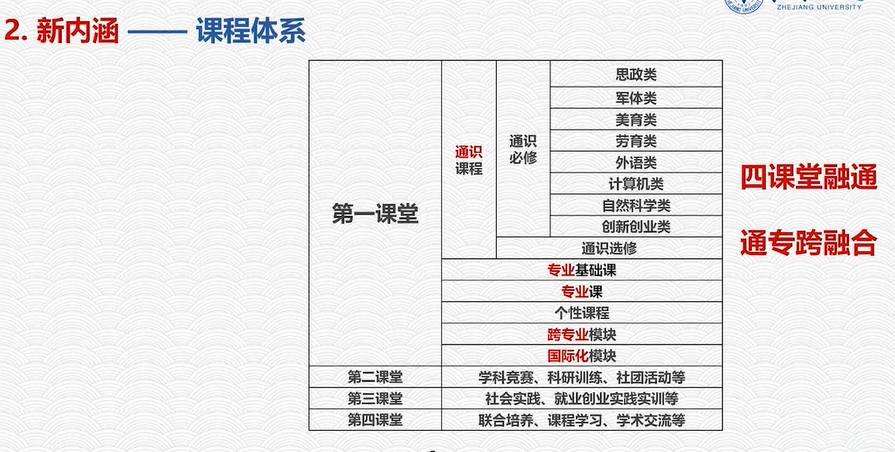 The combination of news agency and major is an eternal theme of our undergraduate education personnel training. News agency education mainly focuses on cultivating students' generous knowledge, excellent ability, comprehensive quality, and sound personality. So news agency education is very important. In 2019, Zhejiang University officially released the White Paper on News Agency Education, reconstructing the Zhejiang University News Agency curriculum system in an all-round way from the combing training model, path management mechanism, and curriculum system, forming a system like six plus 1. We Each has its own end and purpose. At the same time, students pay special attention to the cultivation of the ability of communication and thinking. Therefore, we have set up a number of benefit-level teaching and research centers, including our writing, including public basic courses such as mathematics, computers, electronics, and electronics, to re-consolidate the subject foundation and ability foundation of students in all aspects.
The combination of news agency and major is an eternal theme of our undergraduate education personnel training. News agency education mainly focuses on cultivating students' generous knowledge, excellent ability, comprehensive quality, and sound personality. So news agency education is very important. In 2019, Zhejiang University officially released the White Paper on News Agency Education, reconstructing the Zhejiang University News Agency curriculum system in an all-round way from the combing training model, path management mechanism, and curriculum system, forming a system like six plus 1. We Each has its own end and purpose. At the same time, students pay special attention to the cultivation of the ability of communication and thinking. Therefore, we have set up a number of benefit-level teaching and research centers, including our writing, including public basic courses such as mathematics, computers, electronics, and electronics, to re-consolidate the subject foundation and ability foundation of students in all aspects.
 Professional training is also very important. We want to cultivate students' solid professional knowledge, skill literacy and a basic sense of scientific methods and innovation. Therefore, we work hard on high-level, creativity, and challenge in terms of majors and content, so that our students can pass the study of professional core courses, and their abilities, knowledge, and basic methods and awareness can be improved. . That's why we think about taking all the courses as an important part of educating people, so that every course and every professional course can reflect the guidance of such a value of mission.
Professional training is also very important. We want to cultivate students' solid professional knowledge, skill literacy and a basic sense of scientific methods and innovation. Therefore, we work hard on high-level, creativity, and challenge in terms of majors and content, so that our students can pass the study of professional core courses, and their abilities, knowledge, and basic methods and awareness can be improved. . That's why we think about taking all the courses as an important part of educating people, so that every course and every professional course can reflect the guidance of such a value of mission.
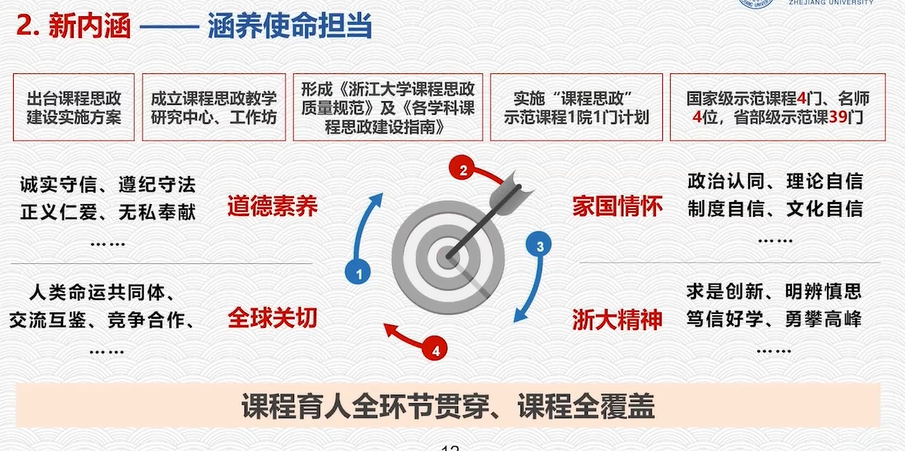 Therefore, we have condensed the four aspects of family and country feelings, the spirit of Zhejiang University, global concern, and moral literacy. This content enables each of our teachers to lead and guide us in a silent way in the process of imparting knowledge. Students can cultivate such a kind of feelings, responsibility, responsibility and concern. The third is that our exploration is a new model. We take the growth of students as the main line of innovation ability as our main starting point. Through the comprehensive and exploratory in-depth practice of experimental practice during school, coupled with giving full play to the advantages of the vast number of teachers and scientific research teams of Zhejiang University, our students can enter the laboratories of various scientific research teams as soon as possible Carry out scientific research training and practice. In addition, we have also carried out a variety of subject competitions, and the number of our students participating is very large, such as more than 5,000 people participating every year.
Therefore, we have condensed the four aspects of family and country feelings, the spirit of Zhejiang University, global concern, and moral literacy. This content enables each of our teachers to lead and guide us in a silent way in the process of imparting knowledge. Students can cultivate such a kind of feelings, responsibility, responsibility and concern. The third is that our exploration is a new model. We take the growth of students as the main line of innovation ability as our main starting point. Through the comprehensive and exploratory in-depth practice of experimental practice during school, coupled with giving full play to the advantages of the vast number of teachers and scientific research teams of Zhejiang University, our students can enter the laboratories of various scientific research teams as soon as possible Carry out scientific research training and practice. In addition, we have also carried out a variety of subject competitions, and the number of our students participating is very large, such as more than 5,000 people participating every year.
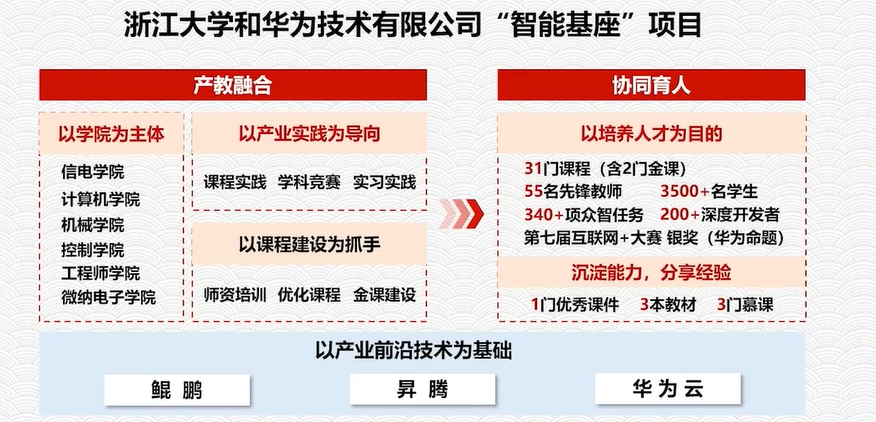 In addition, Zhejiang University's innovation-based entrepreneurship education has also flourished over the years. We have also established the Innovation and Entrepreneurship College, which has also been selected as a national demonstration base for innovation and entrepreneurship. After these years of hard work, we can see that the Chinese Super League has achieved a phased effect in the cultivation of our ability from a data point of view. In the evaluation results of the competitions for the cultivation of disciplines of innovation in Chinese universities over the years, Zhejiang University ranked second in the country. In our previous Internet Plus Challenge Cup competitions, the total number of intensive lectures has also ranked first in the country, and we have also achieved very good results in such world-class subject competitions in various aspects. It should be said that it can be seen from one aspect that our efforts are producing good results.
In addition, Zhejiang University's innovation-based entrepreneurship education has also flourished over the years. We have also established the Innovation and Entrepreneurship College, which has also been selected as a national demonstration base for innovation and entrepreneurship. After these years of hard work, we can see that the Chinese Super League has achieved a phased effect in the cultivation of our ability from a data point of view. In the evaluation results of the competitions for the cultivation of disciplines of innovation in Chinese universities over the years, Zhejiang University ranked second in the country. In our previous Internet Plus Challenge Cup competitions, the total number of intensive lectures has also ranked first in the country, and we have also achieved very good results in such world-class subject competitions in various aspects. It should be said that it can be seen from one aspect that our efforts are producing good results.
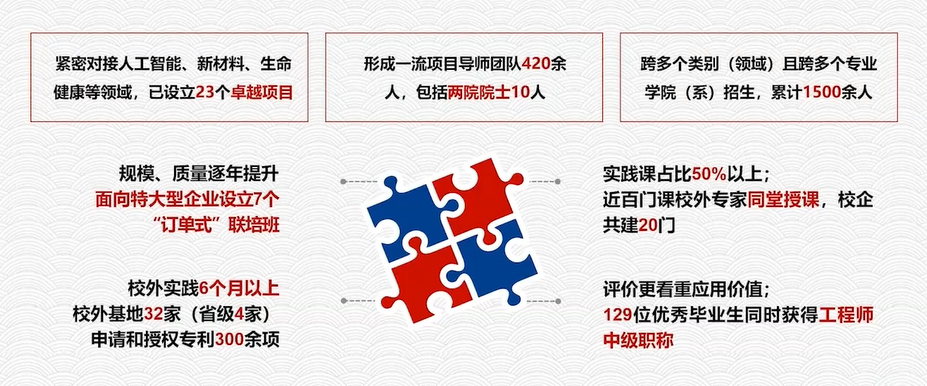 Here, the smart pedestal project we cooperated with Huawei is a very good one for the deep integration of schools and enterprises, the integration of production and education, and collaborative education. This project and example have played a leading role in demonstration. In this process, our Zhejiang University was deeply involved in the project of such an intelligent base with six colleges. Then, starting from the curriculum construction and optimizing the curriculum setting, it is to integrate this cutting-edge technical curriculum of Huawei's industry into our school system. In this process, there are teacher training and the establishment of this course. Then our students are guided by industrial practice and carry out extracurricular practice. Our students also make full use of the platform of the smart base to participate in various academic competitions at all levels.
Here, the smart pedestal project we cooperated with Huawei is a very good one for the deep integration of schools and enterprises, the integration of production and education, and collaborative education. This project and example have played a leading role in demonstration. In this process, our Zhejiang University was deeply involved in the project of such an intelligent base with six colleges. Then, starting from the curriculum construction and optimizing the curriculum setting, it is to integrate this cutting-edge technical curriculum of Huawei's industry into our school system. In this process, there are teacher training and the establishment of this course. Then our students are guided by industrial practice and carry out extracurricular practice. Our students also make full use of the platform of the smart base to participate in various academic competitions at all levels.
 Although we have such a work, such a project has actually not been started for too long, only two years. But in fact, from the current point of view, the results are still very fruitful. Whether it is from the teacher's participation in the development of the curriculum, our students' participation in the development of some projects has achieved very good progress and results. Then I would like to take a little time here to introduce our university's exploration of this new model.
Although we have such a work, such a project has actually not been started for too long, only two years. But in fact, from the current point of view, the results are still very fruitful. Whether it is from the teacher's participation in the development of the curriculum, our students' participation in the development of some projects has achieved very good progress and results. Then I would like to take a little time here to introduce our university's exploration of this new model.
In 2016, Zhejiang University established the country's first graduate-level engineering college. Its purpose is for industry-oriented applications, and it needs to cultivate high-end engineering leaders and internationally competitive craftsmen from developed countries. It appropriately weakens the reason. In our postgraduate training process, we pay more attention to discipline, but more emphasis on industry-oriented, project-oriented is to solve practical problems in the industry. Such a guiding significance is connected across multiple categories and multiple college majors, including the fields of artificial intelligence, new materials, and life and health. We've set up 23 assignments so far, and we actually have a team of teachers mentoring our student teams. This project is a cross-compound project. At the same time, we have also set up 7 order-based joint training classes for very large enterprises. The whole training process pays special attention to the cultivation of practical ability, and the proportion of practical ability courses is very high, more than 50%. Moreover, the courses are co-constructed by schools and enterprises.
In addition, we require students to practice off-campus for more than 6 months. We have also built a number of off-campus bases here, and have made some very good progress, such as applying for some patents. At the same time, there is also a very characteristic feature that our evaluation is not only based on the degree, but also on some application value. With the support of the Human Resources and Social Security Department of Zhejiang Province, we have middle-level engineers who say that such a result can be applied. So over the years, we have also had 129 outstanding graduates, who were awarded engineers as soon as they graduated. It is called a new model promoted by Zhejiang University in response to the needs of the development of national strategic industries, to cultivate excellent engineers through cross-combination. .
Finally, I would like to talk about the fourth aspect of our exploration is the new method. The new method is mainly a digital empowerment. We all know that in response to the development of information technology, promoting the reform and innovation of education is an ascendant trend of higher education in the world. So in 2016 at Zhejiang University, we started the construction of a teaching platform like Zhejiang University. In 2019, we upgraded to version 2.0 and officially launched it. Because of such a previous foundation, when our entire school encountered the sudden new crown epidemic in 2020, we implemented online learning very successfully and smoothly, a kind of learning through information technology.
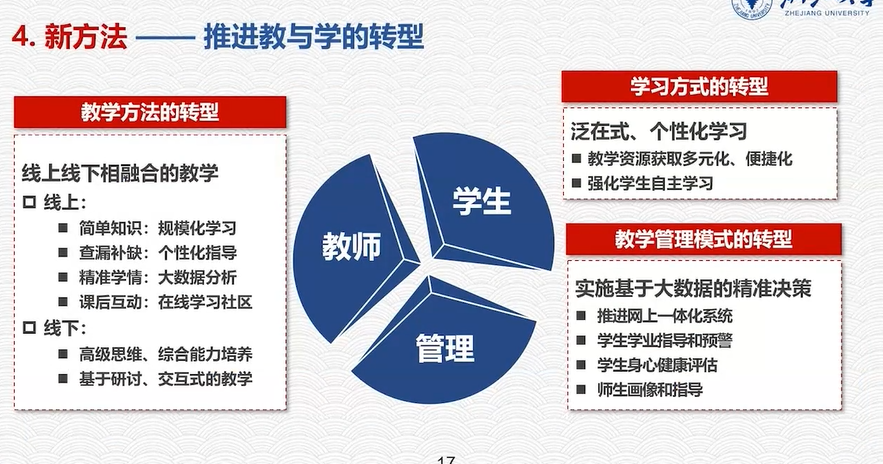 Now we have a large number of new smart classrooms that have been built. We have a teaching platform on the learning platform and a recording and broadcasting platform on the Zhiyun classroom live broadcast. In addition, as an aid in such a situation, we also have some communication platforms established by Zhejiang University. In this way, in the process of learning, students can get a great expansion not only in the classroom, but also in various spaces.
Now we have a large number of new smart classrooms that have been built. We have a teaching platform on the learning platform and a recording and broadcasting platform on the Zhiyun classroom live broadcast. In addition, as an aid in such a situation, we also have some communication platforms established by Zhejiang University. In this way, in the process of learning, students can get a great expansion not only in the classroom, but also in various spaces.
At present, 100% of our courses are built on this big platform. There are more than 30,000 courses on this platform. The total number of users of our courses has exceeded 130,000, and the number of teacher users has exceeded 30,000. is strongly supported. The hybrid online and offline teaching also realizes the seamless connection of offline lectures, offline synchronous classrooms, and online synchronous recording and broadcasting.
What we are currently doing is to use information technology as a supporting condition and transform it into a digital strategic transformation. Through digital empowerment, we will further promote the transformation of teaching and learning through digitalization and intelligence. Just now I mentioned some of the difficulties and problems we are facing. Among them are students' initiative in learning, insufficient active participation, teachers' lectures and other problems. Therefore, through a transformation of learning methods, teaching methods, and teaching management models, we carry out this space application of deepening online learning based on big data to build an effective model for online and offline teaching, and promote normalized applications. In-depth exploration of a teaching application of new technologies such as virtual reality and artificial intelligence to create a networked, immersive, and intelligent model.
Here I want to talk about in particular that through such a digital transformation, we have also promoted a precise transformation of the teaching management model. For example, we can promote an integrated online system, so that our students can get better guidance in the course of their studies, and the assessment of students' physical health can be more accurate. This makes the comprehensive development of our students get a strong support.
Finally, I will make a summary. The construction of new engineering disciplines and personnel training is a systematic project, and I think it is also the biggest in our country of higher education. Then Zhejiang University needs to continue to explore and practice in new majors, new connotations, new models, and new methods. We can only make unremitting efforts to independently cultivate top-notch innovative talents who will lead a new round of technological revolution and industrial transformation by keeping integrity and innovation, and making long-term achievements.
Create a new model: Relying on the "intelligent pedestal" virtual teaching and research room to deepen the teaching reform of computer majors
In order to implement the guiding ideology of accelerating digital development and building a digital China proposed in the 14th Five-Year Digital Economy Development Plan, the Ministry of Education has been vigorously promoting the national education digitalization strategic action. On March 28 this year, the National Smart Education Platform officially launched a new performance, marking the phased results of the educational digitalization strategic action. At the meeting, Minister Huai Bai Jinpeng made important instructions on the strategic actions of education digitalization. The education system should conscientiously implement the important expositions of education and the important instructions on the construction of digital China. Requirements, and firmly promote the national educational digitalization strategy. After entering the stage of popularization, higher education has shown characteristics such as quality diversification, lifelong learning, individualized training, and modernized governance. Under the impact of the wave of new technological revolution, the learning methods, learning content, learning ability and learning form of college students are being restructured at an accelerated rate. The digital development of higher education has become a major strategic issue that affects or even determines the high-quality development of higher education. It is a breakthrough and an innovative path to realize the transformation from learning revolution, quality revolution to high-quality development.
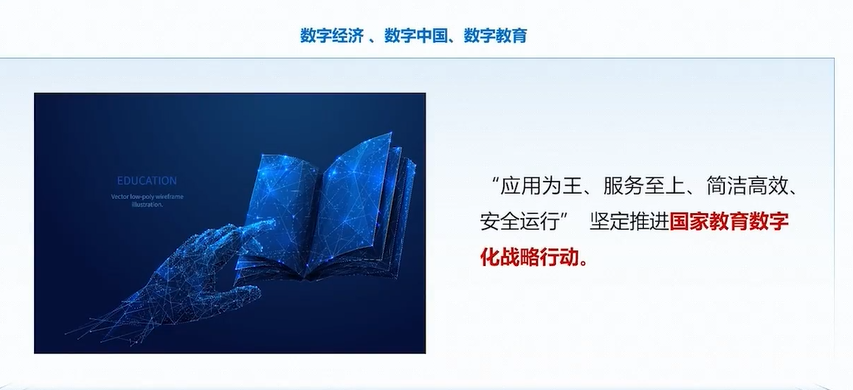 As an important part of the national education digitalization strategy, the higher education digitalization system is also being accelerated, including ten modules including courses, teaching materials, experiments, teaching research, and teaching management. The virtual teaching and research room is the key work of the teaching and research module. In February this year, the General Office of the Ministry of Education officially announced the list of the first batch of pilot construction of virtual teaching and research rooms, and proposed the construction goals of virtual teaching and research rooms and four key construction tasks. It is required that the fundamental task of virtual teaching and research should be to build morality and cultivate people, focus on improving the ability of personnel training, rely on modern information technology, explore and build a new grass-roots teaching organization, create a community of teacher teaching development and quality culture, and guide teachers to return to teaching and love Teaching, research teaching, improving education and teaching capabilities, and providing strong support for the high-quality development of higher education.
As an important part of the national education digitalization strategy, the higher education digitalization system is also being accelerated, including ten modules including courses, teaching materials, experiments, teaching research, and teaching management. The virtual teaching and research room is the key work of the teaching and research module. In February this year, the General Office of the Ministry of Education officially announced the list of the first batch of pilot construction of virtual teaching and research rooms, and proposed the construction goals of virtual teaching and research rooms and four key construction tasks. It is required that the fundamental task of virtual teaching and research should be to build morality and cultivate people, focus on improving the ability of personnel training, rely on modern information technology, explore and build a new grass-roots teaching organization, create a community of teacher teaching development and quality culture, and guide teachers to return to teaching and love Teaching, research teaching, improving education and teaching capabilities, and providing strong support for the high-quality development of higher education.
 This requires the full use of information technology in the virtual collagen, to explore a teacher teaching and research model that breaks through the constraints of time and space, is efficient, convenient, diverse, and combines online and offline, and forms new ideas, methods, and paradigms for the construction and management of grassroots teaching organizations, and promotes teachers. Strengthen the research and exploration of various aspects such as professional construction, curriculum construction, teaching content, teaching methods, teaching methods, teaching evaluation, etc., enhance the awareness of teaching research, and condense and promote research results.
This requires the full use of information technology in the virtual collagen, to explore a teacher teaching and research model that breaks through the constraints of time and space, is efficient, convenient, diverse, and combines online and offline, and forms new ideas, methods, and paradigms for the construction and management of grassroots teaching organizations, and promotes teachers. Strengthen the research and exploration of various aspects such as professional construction, curriculum construction, teaching content, teaching methods, teaching methods, teaching evaluation, etc., enhance the awareness of teaching research, and condense and promote research results.
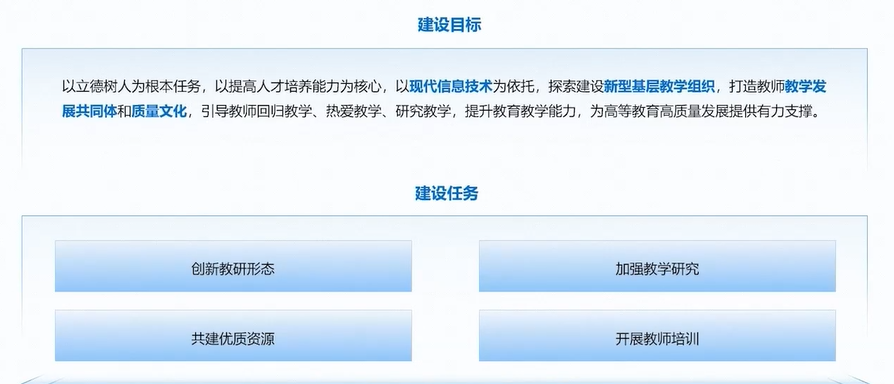 On the basis of sufficient research and communication, members of the virtual teaching and research section are required to collaborate and jointly build resources such as talent training programs, syllabus, knowledge graphs, teaching videos, electronic courseware, exercise questions, teaching cases, experimental projects, training project data sets, etc., to form high-quality Shared teaching resource library. At the same time, normalized teacher training will be carried out, the demonstration and leading role of the national teaching team and the first-class courses of famous teachers will be brought into play, the mature and effective implementation plan of the talent training and sharing model courses will be promoted, and the teaching development of front-line teachers will be promoted.
On the basis of sufficient research and communication, members of the virtual teaching and research section are required to collaborate and jointly build resources such as talent training programs, syllabus, knowledge graphs, teaching videos, electronic courseware, exercise questions, teaching cases, experimental projects, training project data sets, etc., to form high-quality Shared teaching resource library. At the same time, normalized teacher training will be carried out, the demonstration and leading role of the national teaching team and the first-class courses of famous teachers will be brought into play, the mature and effective implementation plan of the talent training and sharing model courses will be promoted, and the teaching development of front-line teachers will be promoted.
 The virtual teaching and research room of the smart pedestal course comes from the Huawei smart pedestal production-education integration collaborative education base of the Ministry of Education. In the first batch of pilot construction of virtual teaching and research rooms, the Ministry of Education specially approved 17 virtual teaching and research rooms related to smart pedestals, and continued to support virtual teaching and research rooms based on empty basin chips, Euler operating system, Gaussian database, Shengteng processors, Shensi AI framework, Huawei Cloud and other more technical teaching and research work fully reflects the Ministry of Education's great emphasis on intelligent pedestals.
The virtual teaching and research room of the smart pedestal course comes from the Huawei smart pedestal production-education integration collaborative education base of the Ministry of Education. In the first batch of pilot construction of virtual teaching and research rooms, the Ministry of Education specially approved 17 virtual teaching and research rooms related to smart pedestals, and continued to support virtual teaching and research rooms based on empty basin chips, Euler operating system, Gaussian database, Shengteng processors, Shensi AI framework, Huawei Cloud and other more technical teaching and research work fully reflects the Ministry of Education's great emphasis on intelligent pedestals.
For the 17 virtual teaching and research rooms of smart pedestals, computer majors, the Education Executive Committee supports Huawei to set up a joint working group to provide organizational guarantee for everyone. Among them, the steering committee is led by 17 virtual teaching and research sections and composed of school-level leaders. It provides macro guidance for the construction of virtual teaching and research sections, provides school-level organizational resources and personnel guarantee for the operation of virtual teaching and research sections, and guides the goal formulation and participation of the virtual teaching and research section of the school. The Steering Committee meeting organized by the joint working group will guide and give advice on the work of the virtual teaching and research section of the smart pedestal.
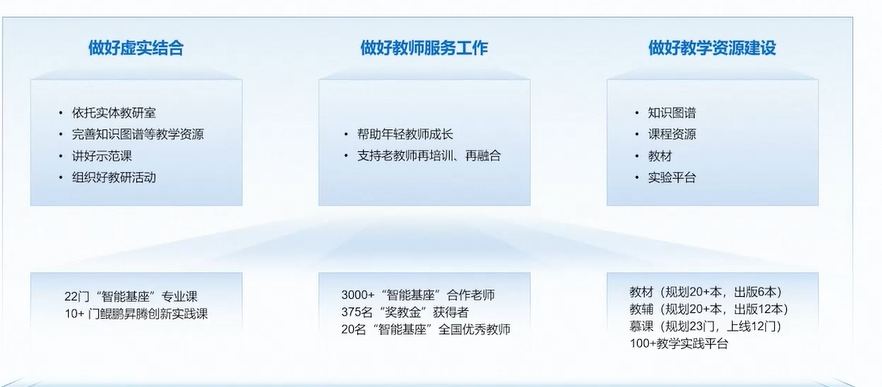 The executive committee is led by 17 virtual teaching and research sections and composed of leaders of the school's academic affairs office. It fully implements the opinions of the steering committee and implements the school's various guarantees for virtual teaching and research sections. According to the quality monitoring system and evaluation system for virtual teaching and research sections, the construction of virtual teaching and research sections Guide the process, participate in the steering committee meeting organized by the joint working group to review and give suggestions on the work of the smart pedestal virtual calibration room.
The executive committee is led by 17 virtual teaching and research sections and composed of leaders of the school's academic affairs office. It fully implements the opinions of the steering committee and implements the school's various guarantees for virtual teaching and research sections. According to the quality monitoring system and evaluation system for virtual teaching and research sections, the construction of virtual teaching and research sections Guide the process, participate in the steering committee meeting organized by the joint working group to review and give suggestions on the work of the smart pedestal virtual calibration room.
The secretariat is composed of our computer professional teaching committee, higher education press, Huawei and other relevant leading members. Several secretariats are set up to handle daily affairs and accept the leadership and supervision of the steering committee. The office is located in Higher Education Press. There are 4 working groups under the secretariat to coordinate the work objectives of each working group, promote the development and implementation of relevant work plans, promote efficient and collaborative creation of course resources, organize teacher training, carry out innovative practice docking high-quality competitions, etc., timely summarize and concise virtual The results of the teaching and research section construction, planning online and offline communication activities covering 17 virtual teaching and research sections, promoting interconnection, and co-constructing and sharing smart machine bases.
The virtual teaching and research room is based on the cutting-edge technology of the industry, and has the latest industrial trends, the latest industrial technology and the latest industrial practice, which will greatly help the development of the construction of the virtual teaching and research room, and can open a window for the integration of production and education. Thus becoming the benchmark in the national virtual teaching and research section. The first problem is the combination of fiction and reality, which can be understood from two aspects. First of all, the virtual verification must rely on the physical teaching and research section to build it. It is necessary to bring the excellent teaching and research experience of the physical teaching and research section of leading universities into the virtual teaching and research section, and drive the member universities and teachers to carry out teaching research and teaching innovation, effectively improve the teaching level of teachers, and improve the quality of classroom teaching. Secondly, the work of the teaching and research section should not be a mere formality, with the help of the virtual teaching and research section work platform. First, the person in charge of the teaching and research section should organize and improve the curriculum outline, knowledge map, multimedia teaching resources and other content, so as to provide reference for carrying out teaching seminars. The second is to lead by example, take the lead in demonstration, teach demonstration courses to all members of the teaching and research section, share the practice and experience of course teaching objectives, teaching concepts, teaching design, teaching methods, etc., play a role of mentoring, and promote the teaching ability of the teaching and research section members.
The third is to regularly organize teaching and research exchange activities in the virtual teaching and research room, and carry out teaching and research exchange activities in the form of online and offline or online and offline integration through public demonstration courses, famous teacher work methods, course trial lectures, and seminars to promote the pilot of virtual teaching and research rooms The construction was carried out in depth. In this area, Huawei has also developed 22 professional courses and more than 10 Kunpeng Ascension Innovation Practice courses together with relevant teachers from universities, which can also be used as an effective input. As for the second question, what I want to say is that if the teaching and research section should do a good job in serving teachers, the first thing is to help young teachers grow up, absorb young teachers with high academic level, actively participate in classroom teaching, and let young teachers put education and teaching into practice. Responsibilities and missions are carried on our shoulders. Secondly, the verification history should focus on the deep integration of informatization and education and teaching and the deep cultivation of advanced education and teaching concepts, and do a good job in the retraining and reintegration of old teachers.
Since the base of the smart base has been in operation for more than a year, more than 3,000 teachers have been empowered, and 375 pillar teachers who have won teaching awards have been selected in 72 smart base construction universities, and 20 teachers have been selected National Excellent Teacher of Smart Pedestal. It is hoped that these outstanding representatives can play a pioneering role, actively participate in the construction of the virtual teaching and research section, and cultivate better teachers.
 The third problem is the construction of teaching resources. The virtual teaching and research room should actively promote the construction of course knowledge maps, course resources, teaching materials and realization platforms. This is the most fundamental starting point for the development of computer course teaching. Without these handles, the work of the teaching and research section will have no support and cohesion. In recent years, the Computer Professional Teaching Steering Committee of our Educational Committee has made great efforts to promote the construction of courses and teaching materials, especially the construction of teaching experiments, to strengthen students' hands-on ability. Some well-known teachers from the Education Committee Eyelian and Huawei universities have developed and successively published more than 40 series of textbooks, and successively launched more than 20 MOOC courses. I also hope that our virtual teaching and research rooms can make the various teaching resources of our professional courses richer and more open, so as to benefit more universities and students. I hope that teachers in the computer field across the country can enjoy this kind of achievement, and more people will participate, and everyone will be a stone flame.
The third problem is the construction of teaching resources. The virtual teaching and research room should actively promote the construction of course knowledge maps, course resources, teaching materials and realization platforms. This is the most fundamental starting point for the development of computer course teaching. Without these handles, the work of the teaching and research section will have no support and cohesion. In recent years, the Computer Professional Teaching Steering Committee of our Educational Committee has made great efforts to promote the construction of courses and teaching materials, especially the construction of teaching experiments, to strengthen students' hands-on ability. Some well-known teachers from the Education Committee Eyelian and Huawei universities have developed and successively published more than 40 series of textbooks, and successively launched more than 20 MOOC courses. I also hope that our virtual teaching and research rooms can make the various teaching resources of our professional courses richer and more open, so as to benefit more universities and students. I hope that teachers in the computer field across the country can enjoy this kind of achievement, and more people will participate, and everyone will be a stone flame.
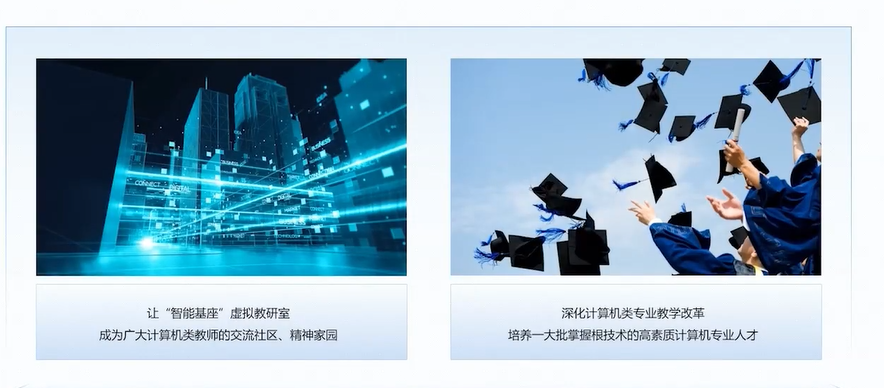 A course on a high intelligence pedestal. The first of the virtual teaching and research section is to gather the strength of the whole country, jointly build and share the teaching and research results, attract more than 3,000 intelligent base cooperation teachers to join, corresponding to the virtual teaching and research section, and develop non-intelligent base colleges and universities and ordinary college teachers to join. We hope that every one of our virtual teaching and research offices can cover, for example, 1,000 colleges and universities within five years.
A course on a high intelligence pedestal. The first of the virtual teaching and research section is to gather the strength of the whole country, jointly build and share the teaching and research results, attract more than 3,000 intelligent base cooperation teachers to join, corresponding to the virtual teaching and research section, and develop non-intelligent base colleges and universities and ordinary college teachers to join. We hope that every one of our virtual teaching and research offices can cover, for example, 1,000 colleges and universities within five years.
The second is to cultivate a group of teaching research and practical results. Within two years, we hope that we can complete two sets of textbooks and MOOCs for different levels of schools and publish them online. The third is to forge a group of high-level teaching team teachers. The training teachers organize two offline teacher training sessions and several online communication and training sessions every year. The fourth is to closely integrate with the industry, improve the practice system, and improve the innovation ability of root technologies through competitions, practices, and student association forums. The construction and development of the virtual teaching and research section is inseparable from the support and support of the member universities and teachers. I hope that all teachers will work together to build and share together, and build the virtual teaching and research room of the smart base into a communication community and spiritual home for the majority of computer teachers. Continue to deepen the teaching reform of computer majors, cultivate a large number of high-quality computer professionals who master root technologies, and contribute to the realization of the goal of accelerating the construction of an important talent center and innovation highland in the world. thank you all.
Building a New Course: Exploring the Cultivation of IT Ecological Innovation Talents
As we all know, curriculum is an important carrier of talent cultivation. As shown in the figure is the process basis of the course setting based on the OB concept and the basic requirements for the implementation of course teaching. On the one hand, we set up our curriculum system based on training goals and graduation requirements. On the other hand, we organize and implement teaching based on the concept of OB, so as to promote the achievement of course goals, and then support graduation requirements and training goals.
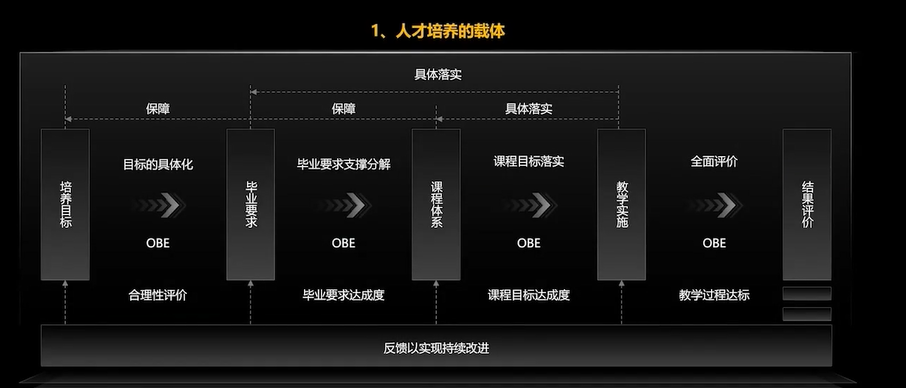 For our computer majors, in order to adapt to the development of the information industry and the requirements for the cultivation of IT ecological innovation talents, we must adjust and optimize our curriculum system according to the needs of the industry, and reform the teaching organization and implementation. From another point of view, the quality of curriculum construction and the effect of teaching are also important indicators for all types of education evaluations at all levels. Curriculum construction, including audit evaluation, qualification evaluation, and professional certification, will be an important indicator.
For our computer majors, in order to adapt to the development of the information industry and the requirements for the cultivation of IT ecological innovation talents, we must adjust and optimize our curriculum system according to the needs of the industry, and reform the teaching organization and implementation. From another point of view, the quality of curriculum construction and the effect of teaching are also important indicators for all types of education evaluations at all levels. Curriculum construction, including audit evaluation, qualification evaluation, and professional certification, will be an important indicator.
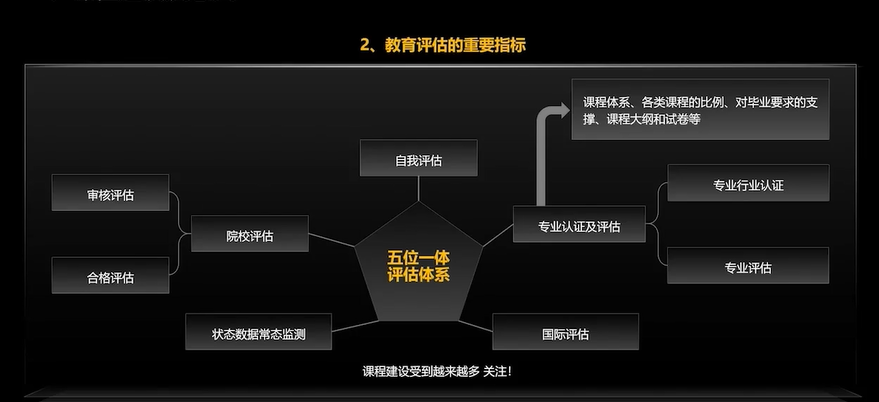 Therefore, curriculum construction has received more and more attention. Since 2003, the Ministry of Education has built several batches of national-level courses, including nearly 4,000 national excellent courses in 2003. The construction of these courses has played a positive role in promoting teaching demonstration and improving teaching quality. In 2013, the Ministry of Education launched the construction of national high-quality resource sharing courses, and built nearly 3,000 national high-quality resource sharing courses, which effectively promoted the integration of modern information technology and education and teaching, and greatly promoted the construction of curriculum resources.
Therefore, curriculum construction has received more and more attention. Since 2003, the Ministry of Education has built several batches of national-level courses, including nearly 4,000 national excellent courses in 2003. The construction of these courses has played a positive role in promoting teaching demonstration and improving teaching quality. In 2013, the Ministry of Education launched the construction of national high-quality resource sharing courses, and built nearly 3,000 national high-quality resource sharing courses, which effectively promoted the integration of modern information technology and education and teaching, and greatly promoted the construction of curriculum resources.
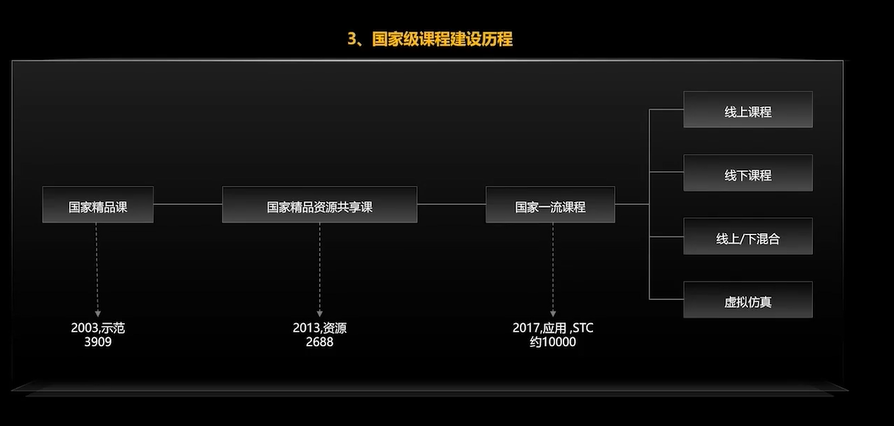 On this basis, in 2017, the Ministry of Education launched a new round of construction of national first-class courses, including online courses, offline courses, online and offline mixed courses, virtual simulation, etc. More than 10,000 courses were built. The extensive promotion and application of this course has greatly improved the quality of personnel training, effectively promoted the implementation of student-centered education and teaching, and played a very positive role in personnel training.
On this basis, in 2017, the Ministry of Education launched a new round of construction of national first-class courses, including online courses, offline courses, online and offline mixed courses, virtual simulation, etc. More than 10,000 courses were built. The extensive promotion and application of this course has greatly improved the quality of personnel training, effectively promoted the implementation of student-centered education and teaching, and played a very positive role in personnel training.
In order to meet the needs of the development of the information industry. We need to improve the high-level, innovative and challenging courses from multiple dimensions. The ultimate goal is to improve students' abilities and adapt to the requirements of industrial development. The three paths of new major construction proposed by the new engineering construction provide very good support for our new curriculum construction. We can build new courses from three dimensions of integration of new courses and updating content.
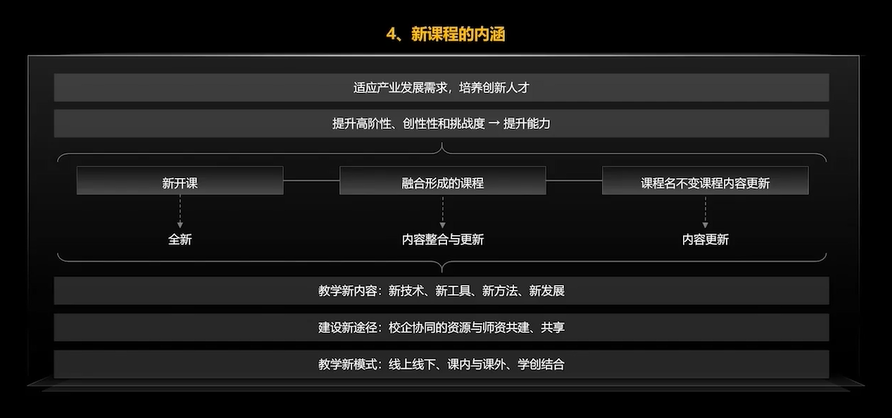 The innovation of courses is multi-dimensional. For example, it can include the innovation of teaching content, and we can introduce new technologies, new tools, new methods and new developments of industrial development. Of course, we can also broaden the new path of curriculum construction, such as school-enterprise collaboration in resource construction and teacher training, as well as resource sharing and co-construction. Then, in terms of teaching mode, we can adopt a blending mode that combines online and offline classes, in-class and extra-curricular learning and singing. The only purpose is to build new courses and improve the quality of the courses. To cultivate innovative talents in it ecology, we must first understand the concept of it ecology. From an ecological point of view, an ecosystem refers to the mutual influence and mutual restriction between organisms and the environment, thus forming a relatively stable dynamic balance. Of course, this balance has a certain timeliness. Referring to this concept, we can also build an IT ecosystem, including basic system hardware such as the CPU from the bottom layer, an operating system in the middle layer, system software such as compiling DBMS, and upper-layer programming tools, application systems, and so on.
The innovation of courses is multi-dimensional. For example, it can include the innovation of teaching content, and we can introduce new technologies, new tools, new methods and new developments of industrial development. Of course, we can also broaden the new path of curriculum construction, such as school-enterprise collaboration in resource construction and teacher training, as well as resource sharing and co-construction. Then, in terms of teaching mode, we can adopt a blending mode that combines online and offline classes, in-class and extra-curricular learning and singing. The only purpose is to build new courses and improve the quality of the courses. To cultivate innovative talents in it ecology, we must first understand the concept of it ecology. From an ecological point of view, an ecosystem refers to the mutual influence and mutual restriction between organisms and the environment, thus forming a relatively stable dynamic balance. Of course, this balance has a certain timeliness. Referring to this concept, we can also build an IT ecosystem, including basic system hardware such as the CPU from the bottom layer, an operating system in the middle layer, system software such as compiling DBMS, and upper-layer programming tools, application systems, and so on.
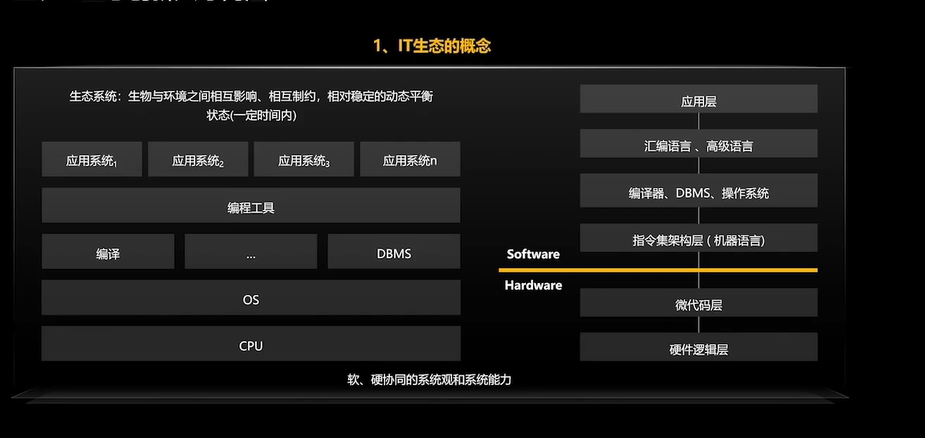 The picture on the right is a simplified diagram of the hierarchical structure of the computer system, which has a relatively good correspondence with the hierarchical structure of the it ecology on the left and the curriculum system for cultivating students' it ecological innovation ability, and it is also the carrier of our courses for cultivating it ecology. Then we need to cultivate students' system view and system ability of soft and hard collaboration. In the information age, IT's key core technology has become the core driving force to support the construction of the world's scientific and technological power and innovation to lead development, which is of great significance to promote high-transformation economic development. Therefore, it is of great significance to cultivate it ecological innovation talents and build an it ecosystem.
The picture on the right is a simplified diagram of the hierarchical structure of the computer system, which has a relatively good correspondence with the hierarchical structure of the it ecology on the left and the curriculum system for cultivating students' it ecological innovation ability, and it is also the carrier of our courses for cultivating it ecology. Then we need to cultivate students' system view and system ability of soft and hard collaboration. In the information age, IT's key core technology has become the core driving force to support the construction of the world's scientific and technological power and innovation to lead development, which is of great significance to promote high-transformation economic development. Therefore, it is of great significance to cultivate it ecological innovation talents and build an it ecosystem.
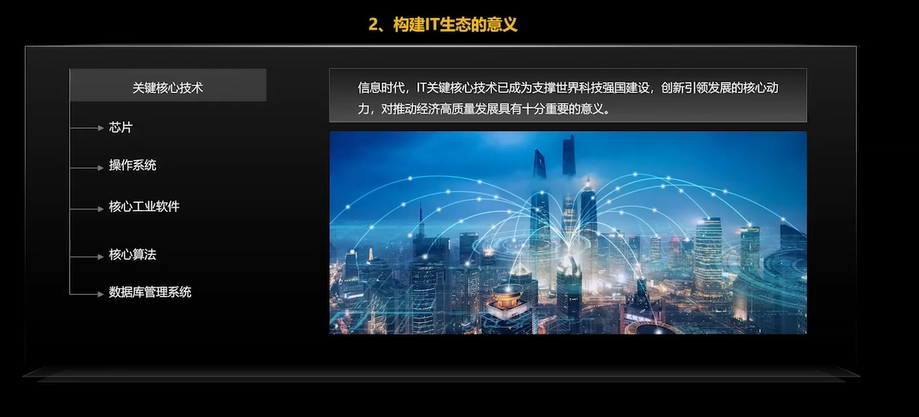 In order to further cultivate it ecological innovation talents, it is necessary for us to interpret the ability elements of it ecological innovation talents. Referring to the system hierarchy diagram of it ecology on the left, we believe that in order to cultivate innovative talents in it ecology, it is necessary to cultivate four levels of ability from high level to low level. It covers the whole ecological chain of it ecology such as design migration, application system development and autonomous system maintenance. Every student in colleges and universities at all levels can find their own position. After understanding the technology chain and ability elements of it ecology, they can well realize the organic connection between technology chain and talent chain, and cultivate more it ecology innovation talents .
In order to further cultivate it ecological innovation talents, it is necessary for us to interpret the ability elements of it ecological innovation talents. Referring to the system hierarchy diagram of it ecology on the left, we believe that in order to cultivate innovative talents in it ecology, it is necessary to cultivate four levels of ability from high level to low level. It covers the whole ecological chain of it ecology such as design migration, application system development and autonomous system maintenance. Every student in colleges and universities at all levels can find their own position. After understanding the technology chain and ability elements of it ecology, they can well realize the organic connection between technology chain and talent chain, and cultivate more it ecology innovation talents .
Based on Kunpeng Ascend and HUAWEI CLOUD technology, the Smart Base Project has established a university talent training system with school-enterprise collaboration, expecting to continue to provide high-quality talents for Kunpeng Ascend and HUAWEI CLOUD industry chain. In order to achieve this goal, I think it is necessary for us to decompose the ability elements of it ecology. I decompose it into the following eight aspects, specifically including the basic knowledge of it ecology, the basic connotation of it ecology, the basic theory and application of building it ecology, the basic tools of it ecology, the maintenance ability of it ecosystem, and the software of it ecology. Hardware migration adaptation, integration and tuning capabilities. There are also the development of application systems based on it's own ecology and the development capabilities of it's ecological basic software and hardware.
 The implementation of the smart machine base project is based on the original training system, and many new teaching elements have been introduced. During the specific implementation process, one or another problem will definitely be encountered. In order to achieve the training goal of intelligent technology, we must solve the teaching problems we face by redesigning the training system. For example, how to embed it ecological technology in principle teaching, how to coordinate between limited knowledge and heart content, how to build supporting resources for newly added teaching content, and the teachers’ cognitive knowledge and The problem of how to update capabilities synchronously.
The implementation of the smart machine base project is based on the original training system, and many new teaching elements have been introduced. During the specific implementation process, one or another problem will definitely be encountered. In order to achieve the training goal of intelligent technology, we must solve the teaching problems we face by redesigning the training system. For example, how to embed it ecological technology in principle teaching, how to coordinate between limited knowledge and heart content, how to build supporting resources for newly added teaching content, and the teachers’ cognitive knowledge and The problem of how to update capabilities synchronously.
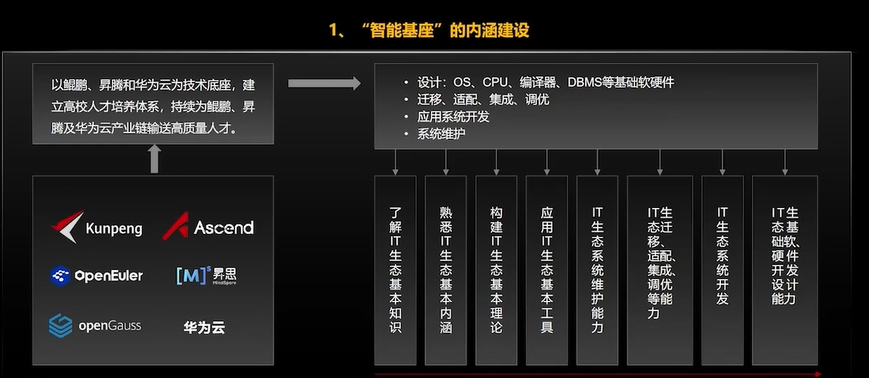 There are also special requirements on how our entire talent training system supports the training of IT ecological innovation talents. In order to achieve the training goal, we can see that among the eight ability elements, some abilities can be cultivated through course teaching and experiment links. As shown in the figure, the three implementation arrows refer to the content and the four dotted arrows point to the content. Of course, these ability elements are difficult to achieve only through course teaching and practice. We also need to cooperate with the simultaneous follow-up of internships, graduation projects, and innovation and entrepreneurship activities to fully achieve the ability elements.
There are also special requirements on how our entire talent training system supports the training of IT ecological innovation talents. In order to achieve the training goal, we can see that among the eight ability elements, some abilities can be cultivated through course teaching and experiment links. As shown in the figure, the three implementation arrows refer to the content and the four dotted arrows point to the content. Of course, these ability elements are difficult to achieve only through course teaching and practice. We also need to cooperate with the simultaneous follow-up of internships, graduation projects, and innovation and entrepreneurship activities to fully achieve the ability elements.
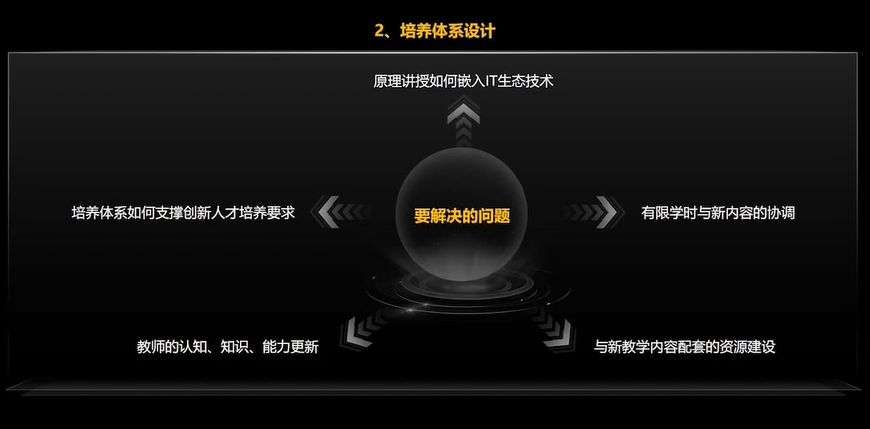 At the same time, simultaneous reform and renewal of education models, teaching methods, and teaching management must be carried out. For example, in the course teaching process, we need to simultaneously implement an education model that combines online and offline, as well as in-class and extra-curricular collaboration. We also need to set up innovation credits and flexible internships and graduation projects to solve students' problems in cultivating and improving their innovative and entrepreneurial capabilities. The problem encountered in the process is that we need to design a smart base for the school-enterprise collaborative training system.
At the same time, simultaneous reform and renewal of education models, teaching methods, and teaching management must be carried out. For example, in the course teaching process, we need to simultaneously implement an education model that combines online and offline, as well as in-class and extra-curricular collaboration. We also need to set up innovation credits and flexible internships and graduation projects to solve students' problems in cultivating and improving their innovative and entrepreneurial capabilities. The problem encountered in the process is that we need to design a smart base for the school-enterprise collaborative training system.
Since its implementation in 2020, we have built 20 courses and have entered the mid-term construction stage. The relevant courses have completed the mid-term benchmarking, and the course construction has achieved remarkable results. In order to further promote intelligence, focus on the quality of post-construction and achieve more results, I think it is necessary to think about the pre-construction process of intelligent production and carry out relevant teaching design.
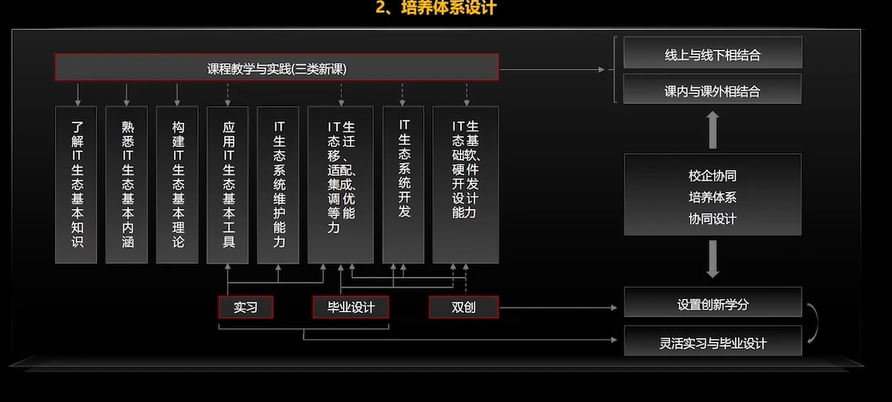 Then, for a few points of thinking, I think that first of all, we need to further clarify the course objectives and design the teaching links. The clarity of our course objectives and the design of links are based on the needs of it ecological innovation talent training. So specifically, at this stage of clarifying the course objectives, I think we should start from the ability map that it ecological innovation talents should have, to find the corresponding knowledge map, and then connect with the course goals. Of course, in-depth and extensive school-enterprise connection should be carried out in this process. After clarifying the objectives of the course, let's optimize it.
Then, for a few points of thinking, I think that first of all, we need to further clarify the course objectives and design the teaching links. The clarity of our course objectives and the design of links are based on the needs of it ecological innovation talent training. So specifically, at this stage of clarifying the course objectives, I think we should start from the ability map that it ecological innovation talents should have, to find the corresponding knowledge map, and then connect with the course goals. Of course, in-depth and extensive school-enterprise connection should be carried out in this process. After clarifying the objectives of the course, let's optimize it.
1 The new content corresponding to the target should be newly added. This is the reform of our course teaching based on the OB concept. At the same time, in order to help achieve the goals of the course, especially the goals related to the newly added it ecological innovation ability, we need to simultaneously design the teaching links, including the synchronization of theoretical teaching and practical teaching, and the synchronization of online and offline teaching . At the same time, it is necessary to clarify the content and requirements of the assessment. It is necessary to formulate the content related to the it ecological innovation ability and honor to the course objectives. It is necessary to formulate clear assessment content and specific requirements, so as to effectively support the achievement of the course objectives.
Second, we must make full use of existing teaching resources, and we can introduce new resources from the following five dimensions, including smart bases. During the implementation process, some resources provided to us by course docking engineers include PPT courseware teaching cases and so on. In addition, Huawei's official website also provides a wealth of other teaching resources and tools and resources needed for course practice. In addition, during the construction of the smart base for more than a year, a large number of excellent teaching materials and MOOC resources have been produced, which are also the resources that can be introduced in our teaching. In addition, Huawei also has cloud resources and hardware resources such as development boards and servers provided during the implementation of the smart base.
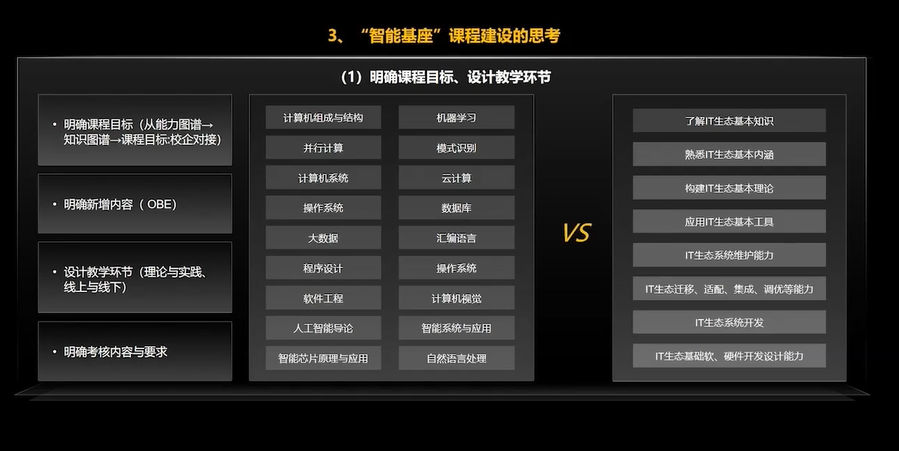 Third, I think it is necessary to strengthen the classification based on the intelligent base root technology, and to implement new experiments in layers. Relying on the real environment, real scenarios and real propositions provided to us by the information industry, we must carry out multi-dimensional innovation and entrepreneurship activities, including development activities in open source communities and developer communities, and a series of innovative activities associated with smart pedestals. Competition, as well as Kunpeng Shengteng's Talent Internship Program and Crowdwisdom Program. Why do I place special emphasis on grading and stratification? Because the 20 courses of intelligent base construction are distributed in different grades of our major. Then, with the deepening of the course study, the students' ability is also gradually improved. Therefore, at this time, we have to support innovation and entrepreneurship activities other than course content at each stage, so as to improve their innovation and entrepreneurship capabilities in an all-round way.
Third, I think it is necessary to strengthen the classification based on the intelligent base root technology, and to implement new experiments in layers. Relying on the real environment, real scenarios and real propositions provided to us by the information industry, we must carry out multi-dimensional innovation and entrepreneurship activities, including development activities in open source communities and developer communities, and a series of innovative activities associated with smart pedestals. Competition, as well as Kunpeng Shengteng's Talent Internship Program and Crowdwisdom Program. Why do I place special emphasis on grading and stratification? Because the 20 courses of intelligent base construction are distributed in different grades of our major. Then, with the deepening of the course study, the students' ability is also gradually improved. Therefore, at this time, we have to support innovation and entrepreneurship activities other than course content at each stage, so as to improve their innovation and entrepreneurship capabilities in an all-round way.
 The fourth point is to strengthen the two-dimensional training of responsibility training. In addition to participating in the regular training organized by the smart base, there is now a new dimension, that is, the virtual teaching and research rooms rely on the smart base to build nearly 20 virtual teaching and research rooms. It also corresponds to our smart base course. Therefore, in the link of teacher training, we will participate in a large number of teaching and research activities in the virtual teaching and research room corresponding to the smart machine base course in the follow-up stage, and introduce the results of teaching and research into our course teaching, which will not only enrich our teaching content, but also improve the teacher's teaching ability to further improve the teaching quality of our courses. Next, I will share some specific actions I took in the course construction in combination with the computer composition principles of the course I hosted on the smart base. First of all, in the link of course objectives, we centered on the eight competency elements of the intelligent base, and introduced four aspects in the dimension of course objectives, such as the basic knowledge of it ecology. Familiar with the basic connotation of it ecology. In this link, we emphasize the need to cultivate students' ability to design adaptation and optimization of software and hardware collaboration. In the link of building the basic theory of it ecology, we rely on the instruction system of the course teaching and the hierarchical structure of the computer system to teach students the theory and method of migration and tuning between the hardware and system software of the it ecology. In the practice session, in order to improve students' ability to design independent hardware and software based on it ecology, we have newly added a CPU design practice session based on arm instructions.
The fourth point is to strengthen the two-dimensional training of responsibility training. In addition to participating in the regular training organized by the smart base, there is now a new dimension, that is, the virtual teaching and research rooms rely on the smart base to build nearly 20 virtual teaching and research rooms. It also corresponds to our smart base course. Therefore, in the link of teacher training, we will participate in a large number of teaching and research activities in the virtual teaching and research room corresponding to the smart machine base course in the follow-up stage, and introduce the results of teaching and research into our course teaching, which will not only enrich our teaching content, but also improve the teacher's teaching ability to further improve the teaching quality of our courses. Next, I will share some specific actions I took in the course construction in combination with the computer composition principles of the course I hosted on the smart base. First of all, in the link of course objectives, we centered on the eight competency elements of the intelligent base, and introduced four aspects in the dimension of course objectives, such as the basic knowledge of it ecology. Familiar with the basic connotation of it ecology. In this link, we emphasize the need to cultivate students' ability to design adaptation and optimization of software and hardware collaboration. In the link of building the basic theory of it ecology, we rely on the instruction system of the course teaching and the hierarchical structure of the computer system to teach students the theory and method of migration and tuning between the hardware and system software of the it ecology. In the practice session, in order to improve students' ability to design independent hardware and software based on it ecology, we have newly added a CPU design practice session based on arm instructions.
 In the part of teacher training, we participated in all the teacher trainings related to the courses organized by the smart base, and all the teachers participated in the training. In addition, we also participated in the teaching and research activities of related virtual teaching and research rooms. During this process, we were fortunate to host a project based on our course content but higher than the course content. In the face of the virtual teaching and research room of the intelligent hardware system course group required by the future intelligent era, we will also actively promote the construction of the virtual education room in the later stage, and share the results of the construction of the virtual education room with everyone in a timely manner to help the construction quality of the hardware course Gradually improve.
In the part of teacher training, we participated in all the teacher trainings related to the courses organized by the smart base, and all the teachers participated in the training. In addition, we also participated in the teaching and research activities of related virtual teaching and research rooms. During this process, we were fortunate to host a project based on our course content but higher than the course content. In the face of the virtual teaching and research room of the intelligent hardware system course group required by the future intelligent era, we will also actively promote the construction of the virtual education room in the later stage, and share the results of the construction of the virtual education room with everyone in a timely manner to help the construction quality of the hardware course Gradually improve.
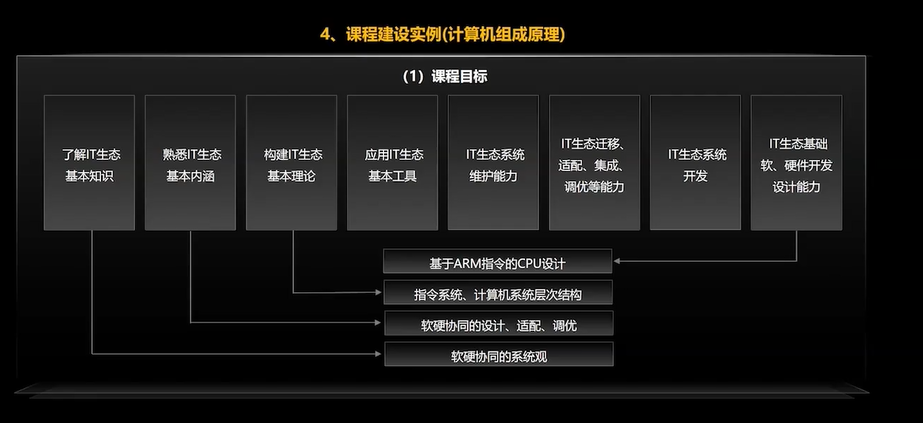 In the process of building the computer organization principle course, we have introduced rich course resources such as teaching materials, video cases, online experiments, and online tests provided by the intelligent base in multiple dimensions, which strongly supports the new training requirements for the intelligent base. Increased course objectives.
In the process of building the computer organization principle course, we have introduced rich course resources such as teaching materials, video cases, online experiments, and online tests provided by the intelligent base in multiple dimensions, which strongly supports the new training requirements for the intelligent base. Increased course objectives.
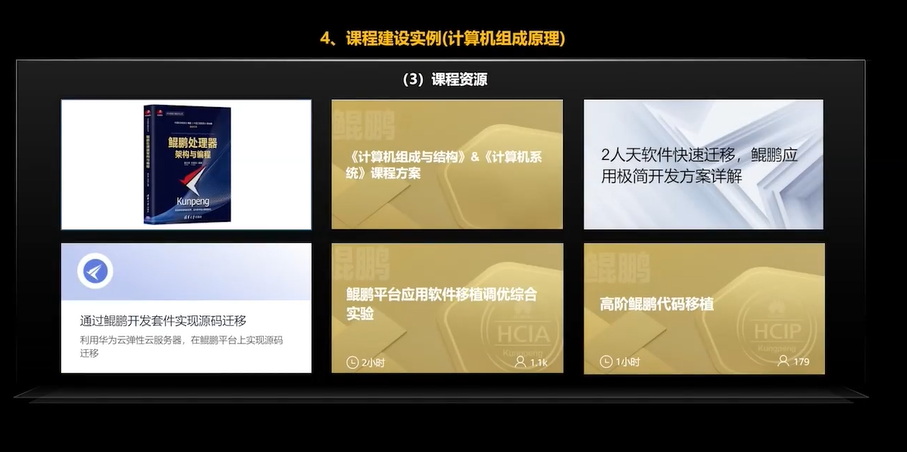 In practice, we use the PPT provided by the docking teacher and the migration tool provided by the official website to allow students to carry out the migration experience outside of class, so as to deepen the experience of cultivating the innovation ability of the IT ecosystem and improve their capabilities. During this process, we also encourage students to actively participate in innovation and entrepreneurship competitions related to the course content, such as the Internet-added Kunpeng Industry Track competition and the software open source innovation competition, etc.
In practice, we use the PPT provided by the docking teacher and the migration tool provided by the official website to allow students to carry out the migration experience outside of class, so as to deepen the experience of cultivating the innovation ability of the IT ecosystem and improve their capabilities. During this process, we also encourage students to actively participate in innovation and entrepreneurship competitions related to the course content, such as the Internet-added Kunpeng Industry Track competition and the software open source innovation competition, etc.
 And it has achieved a series of achievements such as the champion of the Internet loading industry track. In the later stage of course construction, we will continue to strengthen the course construction, actively introduce new resources for intelligent infrastructure construction, expect to achieve better results, and contribute our own strength to the cultivation of the creators of it ecology. At the same time, I also hope that the teachers of intelligent production will continue to achieve more and better results in the later construction process, and jointly cultivate more innovative talents with root technology for the intelligent base, and jointly cultivate more innovative talents for the innovative development of the information industry. ecological innovation talents.
And it has achieved a series of achievements such as the champion of the Internet loading industry track. In the later stage of course construction, we will continue to strengthen the course construction, actively introduce new resources for intelligent infrastructure construction, expect to achieve better results, and contribute our own strength to the cultivation of the creators of it ecology. At the same time, I also hope that the teachers of intelligent production will continue to achieve more and better results in the later construction process, and jointly cultivate more innovative talents with root technology for the intelligent base, and jointly cultivate more innovative talents for the innovative development of the information industry. ecological innovation talents.
Implementing new practices—the growth path of innovative practices based on Ascend’s full-stack Al software and hardware technology
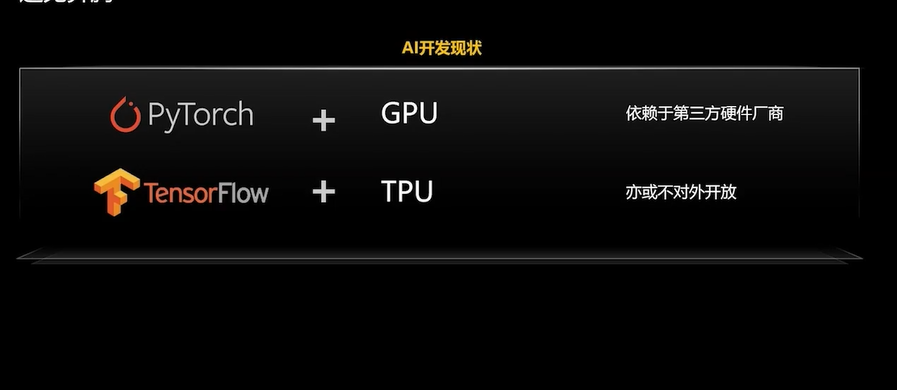
Nowadays, due to the upgrading of AI models, AI developers are increasingly relying on mature AI software and hardware development framework systems. The mainstream development system can basically be divided into two types. One is the PyTorch framework, which generally needs to rely on GPU hardware to achieve fast tensor operations. The other is the tensorflow framework. Compared with PyTorch, it has a self-developed hardware structure, and the TPU calculation speed is faster and more efficient. However, the TPU is not open to the public, and everyone can only use the GPU to calculate. But after all, GPU is not a hardware specially designed for AI algorithms, and its computing efficiency is not as good as TPU.
At the same time, for domestic developers, it is not a comfortable thing to rely on the software and hardware development system of foreign companies. Just last year, I learned about Shenteng, a domestic AI software and hardware development system, which has a self-developed AI software development framework.
 Based on Mindsport, Mindsport provides users with high-level API interfaces, enabling rapid development of AI software algorithms applicable to all walks of life. In terms of hardware, Shensi proposed the heterogeneous computing architecture of CNN, which allows Shensi's algorithms to run on a variety of processors, especially on the atlas series hardware developed by Shenteng, which can run efficiently and quickly. At the same time, Shenteng also provides the development tool mind studio for the whole process of software and hardware, as well as the management operation and maintenance tools fusion director and smart kit to provide a full range of development and maintenance services for users of different needs and sizes. The generated hardware performance is very pleasant to me. of. Take atlas 200 as an example, it can achieve up to 22 tops of int 8 computing performance and 11 tflups of half-precision floating point performance with only 8 watts of power consumption. With very obvious advantages, it provides sufficient guarantee for the edge landing of the software.
Based on Mindsport, Mindsport provides users with high-level API interfaces, enabling rapid development of AI software algorithms applicable to all walks of life. In terms of hardware, Shensi proposed the heterogeneous computing architecture of CNN, which allows Shensi's algorithms to run on a variety of processors, especially on the atlas series hardware developed by Shenteng, which can run efficiently and quickly. At the same time, Shenteng also provides the development tool mind studio for the whole process of software and hardware, as well as the management operation and maintenance tools fusion director and smart kit to provide a full range of development and maintenance services for users of different needs and sizes. The generated hardware performance is very pleasant to me. of. Take atlas 200 as an example, it can achieve up to 22 tops of int 8 computing performance and 11 tflups of half-precision floating point performance with only 8 watts of power consumption. With very obvious advantages, it provides sufficient guarantee for the edge landing of the software.
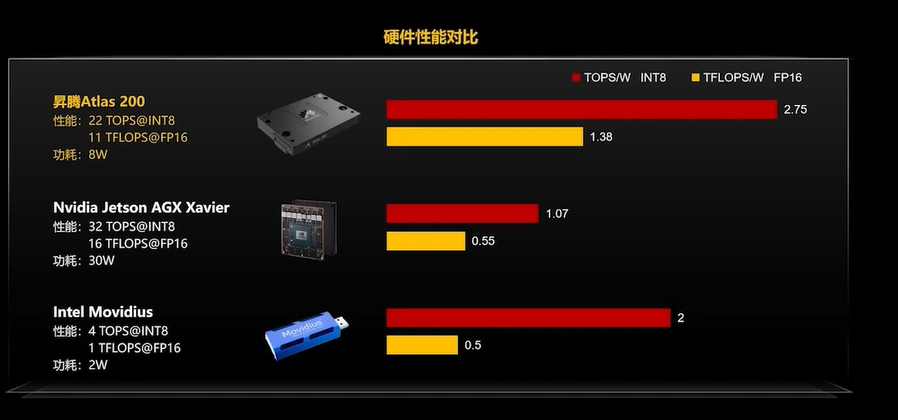 When I started to learn Shengteng, the first thing I encountered was atlas 200, a deep learning acceleration module. Ascend provides beginners with the atlas 200 DK development board, which can be connected to the camera network port to support our developers to do some simple camera vision applications. Deep also provides us with a complete learning system from easy to difficult to help developers grow quickly. It also provides us with a quick-start tutorial that allows us to learn how to run a neural network for image recognition on the atlas 200 in just 20 minutes.
When I started to learn Shengteng, the first thing I encountered was atlas 200, a deep learning acceleration module. Ascend provides beginners with the atlas 200 DK development board, which can be connected to the camera network port to support our developers to do some simple camera vision applications. Deep also provides us with a complete learning system from easy to difficult to help developers grow quickly. It also provides us with a quick-start tutorial that allows us to learn how to run a neural network for image recognition on the atlas 200 in just 20 minutes.
Ascend's community resources can facilitate developers to communicate with each other and answer questions. At the same time, Ascend will hold a long-term CNN training camp to meet the needs of developers for in-depth learning. In terms of software, Mindsport has its own independent official website, which also provides sufficient tutorials, development guides, API interfaces, documents, etc. Based on these learning tutorials, I completed the transformation and upgrading from entry to application to in-depth development.
Shengsi also has community resources similar to atlas. We can ask questions in the community. If we feel that a certain API interface design is unreasonable, or some functions have not been implemented, we can even post an issue on git EE to generate official added functions to meet our development needs. Deep has also carried out various forms of workshops and sharing sessions to broaden the horizons of developers and improve their development skills. Next, I would like to share some of my experience in Ascend development.
At the very beginning, I found that the atlas 200dk has relatively few expansion interfaces, and is not suitable for the control of an embedded device, it is the core. So me and my team members need to redesign the core driver version of atlas 200. Shenteng officially provides atlas 200 hardware development guide for developers.
On this, we can determine the physical parameters and electrical signal parameters of each interface of atlas 200. After confirming the parameters, we can select the corresponding peripheral chips according to the interfaces we need, such as network driver chips, sensor chips, PCIe chips, and so on. After that, draw the schematic diagram and send the PCB to the board yard to block the sample, and the SMT company will patch it or solder it by yourself, and finally debug the overall circuit of the circuit board.
After completing the design and production of the hardware, we need to add the driver software of the peripheral interface devices we need to the Linux kernel running on the atlas 200. Here I take the PCIe-to-USB interface as an example. Since atlas 200 does not reserve a USB interface, in order to use these USB devices, we need to use a PCIe-to-USB chip to achieve this goal.
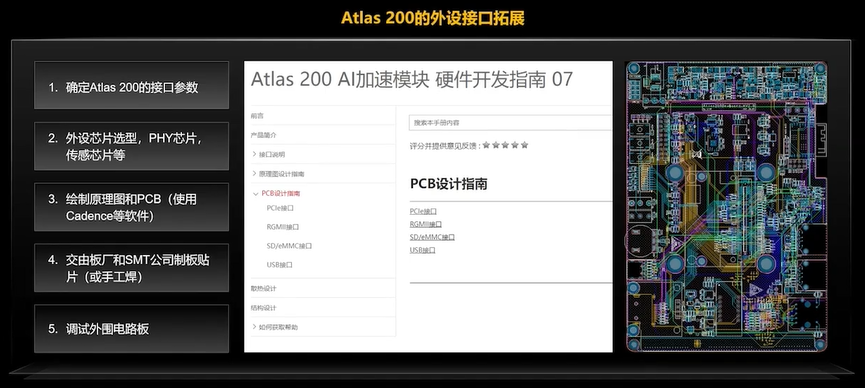 We need to transplant the PCIe to USB driver, and add the PCIe to USB chip driver to the Linux kernel. In order to drive the camera or U disk through USB, we also need to add the camera or the fact file system or some other USB device driver programs to our kernel, and finally compile the modified kernel and device numbers to obtain A kernel that supports these new USB device drivers. My team members and I redesigned the peripheral interface circuit of atlas 200, and made a core version with UA rt iPhone C SPI USB PCIe and other interfaces. Based on this core version and the powerful computing power of atlas 200, I led our team members to develop an AI intelligent photography system, which won the national silver award in the industry track of the 2021 Internet University Student Innovation and Entrepreneurship Competition. At the same time, this core version is also used by team instructors in the school's embedded course teaching because of its rich expansion interface and rich features.
We need to transplant the PCIe to USB driver, and add the PCIe to USB chip driver to the Linux kernel. In order to drive the camera or U disk through USB, we also need to add the camera or the fact file system or some other USB device driver programs to our kernel, and finally compile the modified kernel and device numbers to obtain A kernel that supports these new USB device drivers. My team members and I redesigned the peripheral interface circuit of atlas 200, and made a core version with UA rt iPhone C SPI USB PCIe and other interfaces. Based on this core version and the powerful computing power of atlas 200, I led our team members to develop an AI intelligent photography system, which won the national silver award in the industry track of the 2021 Internet University Student Innovation and Entrepreneurship Competition. At the same time, this core version is also used by team instructors in the school's embedded course teaching because of its rich expansion interface and rich features.
 When we have completed the hardware design and development, the next step is to develop the software. Today I would like to introduce the model migration method on mindsport. If you have a model that was originally written in other frameworks such as PyTorch or tensorflow, we will port it to the deep thinking framework. Then just follow the steps below to achieve your goal step by step.
When we have completed the hardware design and development, the next step is to develop the software. Today I would like to introduce the model migration method on mindsport. If you have a model that was originally written in other frameworks such as PyTorch or tensorflow, we will port it to the deep thinking framework. Then just follow the steps below to achieve your goal step by step.
At the beginning, we need to analyze the original model to see if there are some operators or modules that are missing. If it is, we must first complete these missing modules. And in the version of minus BOOL, Shensi 1.7, it provides us developers with new functions, that is, we can customize an operator. Then after customizing the development operator, we need to develop the model definition file of the overall network, and we need to complete the missing modules. Then we need to write the overall network definition structure definition file.
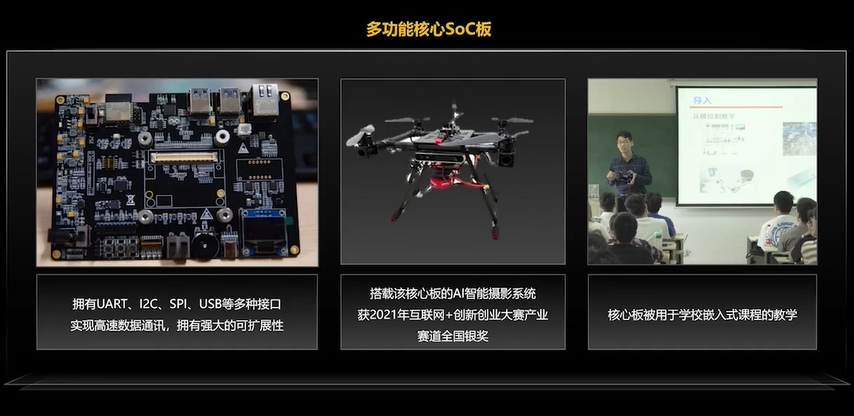 Deep Thought provides a very convenient tool called mind converter, which can automatically convert the original model into Deep Thought code and Deep Thought model parameters. By loading the same input into models of different frameworks and comparing their output differences, we can verify the correctness of the model code. Then we can debug the overall training or testing process of the network, and optimize the accuracy of the network. In the end, we were able to successfully convert the models of other frameworks into the model code and model parameters of the Deep Thought version.
Deep Thought provides a very convenient tool called mind converter, which can automatically convert the original model into Deep Thought code and Deep Thought model parameters. By loading the same input into models of different frameworks and comparing their output differences, we can verify the correctness of the model code. Then we can debug the overall training or testing process of the network, and optimize the accuracy of the network. In the end, we were able to successfully convert the models of other frameworks into the model code and model parameters of the Deep Thought version.
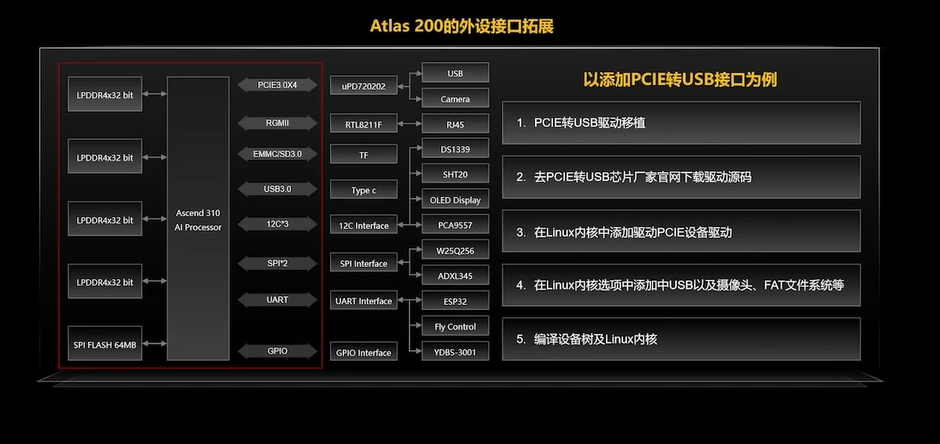 Let me take the video swing transformer model, which is the reproduction process of swing 3D, as an example. First of all, we need to analyze this model to see which operators are missing. The row 3D operator is missing in 3D. Then we need to reproduce it on the deep thinking framework according to a function of its original framework. Then we can develop the overall model code. Due to the complex structure of swing 3D, we need to write code layer by layer.
Let me take the video swing transformer model, which is the reproduction process of swing 3D, as an example. First of all, we need to analyze this model to see which operators are missing. The row 3D operator is missing in 3D. Then we need to reproduce it on the deep thinking framework according to a function of its original framework. Then we can develop the overall model code. Due to the complex structure of swing 3D, we need to write code layer by layer.
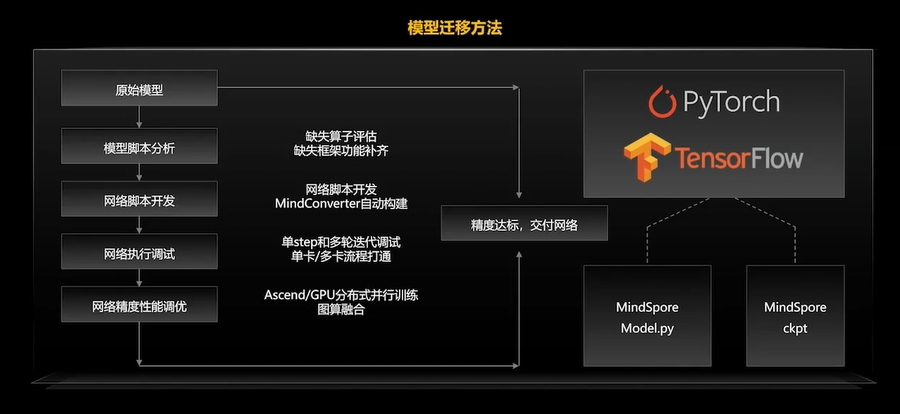 First of all, we need to write a basic unit called swing transformer block. Then we stack the blocks on the basis of this block. After developing the overall swing 3D model, we convert the parameters of the original model into the format of parameters of the Shensi model. To compare whether the output of the model under the two frameworks is different, to verify whether the swing 3D model code we transplanted is correct. Finally, the code writing of the overall training and testing process is carried out.
First of all, we need to write a basic unit called swing transformer block. Then we stack the blocks on the basis of this block. After developing the overall swing 3D model, we convert the parameters of the original model into the format of parameters of the Shensi model. To compare whether the output of the model under the two frameworks is different, to verify whether the swing 3D model code we transplanted is correct. Finally, the code writing of the overall training and testing process is carried out.
 In the swing 3D model, there are some unique settings that Shensi does not yet have, such as the definition function of its learning rate, its optimizer or loss function, and the dataset pipeline. Writing, and some video IO interface writing. During the porting process, Deep Thought provides a mapping table between other framework APIs and its own framework API. Our developers can easily query the corresponding interface of the migrated target function, so as to avoid some low-level mistakes and facilitate us to quickly debugswing 3D as a video understanding model, which is part of the mind vision suite below.
In the swing 3D model, there are some unique settings that Shensi does not yet have, such as the definition function of its learning rate, its optimizer or loss function, and the dataset pipeline. Writing, and some video IO interface writing. During the porting process, Deep Thought provides a mapping table between other framework APIs and its own framework API. Our developers can easily query the corresponding interface of the migrated target function, so as to avoid some low-level mistakes and facilitate us to quickly debugswing 3D as a video understanding model, which is part of the mind vision suite below.
 mind vision is a suite dedicated to vision tasks. It provides the data set pipeline and IO interface related to vision tasks, and also provides log and visualization modules to facilitate our developers to develop. mind vision covers a variety of vision tasks, such as image classification, video understanding, image detection, point cloud recognition, and more. On each task, mandivision reproduces multiple mainstream algorithm models. At present, some API interface documents of mandivision are available on the Shensi official website. At the same time, the related models that have been developed have been open sourced in git, and have been open sourced in the sense of git.
mind vision is a suite dedicated to vision tasks. It provides the data set pipeline and IO interface related to vision tasks, and also provides log and visualization modules to facilitate our developers to develop. mind vision covers a variety of vision tasks, such as image classification, video understanding, image detection, point cloud recognition, and more. On each task, mandivision reproduces multiple mainstream algorithm models. At present, some API interface documents of mandivision are available on the Shensi official website. At the same time, the related models that have been developed have been open sourced in git, and have been open sourced in the sense of git.
In the process of developing the deep layer, I found that the software and hardware of the deep layer have a very high degree of development freedom. In software, you can customize model operators to optimize your entire algorithm. In terms of hardware, you can customize the peripheral driver circuit board to make corresponding designs and changes for your actual application scenarios. These provide sufficient convenience for the development and implementation of AI products. At the same time, the fully localized software and hardware development system makes me feel more at ease when using it.
On the other hand, deep can always solve my doubts quickly, whether it is atlas or deep thinking, as long as I post my question on the forum or git meaning, other developers or official technology The staff can always give an accurate reply within three or four hours, saving me a lot of development time.
Universities are like lighthouses, lighting the road of education and cultivating eclectic and innovative talents. Looking forward to the future, we will work together to deepen the cultivation of new engineering talents based on the smart machine base, and contribute our own strength to the development of the new computing industry